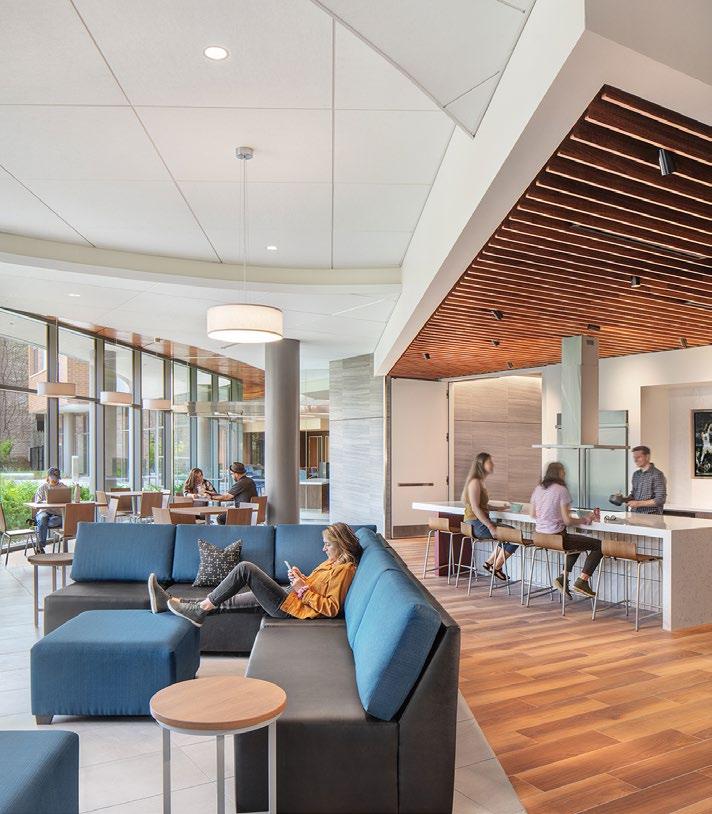THE ELEPHANT ON CAMPUS
Student Housing Renovations
SCB Architecture, Planning, Interior and Urban Design




Student Housing Renovations
SCB Architecture, Planning, Interior and Urban Design



The building boom on college and university campuses following World War II produced a plethora of significant student housing structures across the United States. They were typically multistory dormitories designed to house the maximum number of students as efficiently as possible. The structures were often minimalistic in design and incorporated materials of lasting legacy including cast-in-place concrete, brick, and strategic use of asbestos. Amenity spaces were limited, often relegated to basement recreation lounges.
Fast-forward to the present day. Many of these workhorse residence halls are still in operation. While they continue to generate significant revenue, deferred maintenance costs grow year after year. And though occupancy rates remain high, they are not meeting the needs or expectations of modern students. Countless universities and colleges face the dilemma of what to do with these elephants on their campuses. Should these structures be slated for demolition and replaced with new construction? Or are there ways to effectively renovate and modernize these buildings for the next 50 years?
The process of determining what to do with these aging structures can be daunting. There are multiple factors to consider and often contradictory voices and competing priorities from the various stakeholders involved with campus housing such as residential life, student services, dining, finance, facilities, and security.
SCB has guided numerous institutions through an evaluation process aimed at helping weigh the challenges and opportunities posed by both renovation and replacement. As outlined in the following pages, this process includes validating a facility’s location within the campus master plan, analyzing current structural and mechanical systems conditions and performance, studying the potential for modifications to the existing floorplan, and exploring strategies for building a sense of community. Also presented are a series of case studies from Arizona State University, Drexel University, Northwestern University, Ball State University, and Butler University which share how each institution approached their respective Elephants on Campus.
Campuses grow and change over time, and land uses shift in response to new priorities and opportunities. The first step in the evaluation process is to confirm that the building’s function and location are supported by the campus master plan. Is it still located in a residential district or in a place that makes sense for housing? Are there supporting student life amenities nearby like dining or fitness? Is the site accessible and along transportation routes? Although anomalies exist on every campus, these significant housing structures have a major impact on the campus and its future growth. In addition, the building should be considered in relation to any greater sustainability goals for the campus as a whole. If the existing building does not work within an institution’s overall plans, it should be studied for demolition and relocation.
If the building still fits within the overall campus master plan, an institution should proceed to evaluate the building’s structure and enclosure. Many of these facilities typically have a heavy concrete structure designed for permanence. The cost of structural upgrades to meet current building and seismic codes can be significant and challenging. Combined with other faults with the building including layout, unit design, future flexibility, density, etc., replacement may become the most efficient option; however, if the structure can be re-used, it can yield anywhere from a six to ten percent cost savings.
The next step in the evaluation process is a thorough review of the building’s mechanical systems including HVAC, plumbing, and fire protection. In many cases, these aging systems have met the end of their life cycle and are performing inefficiently. Even if a facilities group has maintained these systems through a strong replacement and deferred maintenance program, technological advancement and innovation have produced far better performing systems.

Perhaps the most complex aspect of evaluating a building for renovation or replacement is studying the overall program and floor plans. Overall, the building must be measured against today’s standards. Does it help build community? What amenities does it offer residents? Does it support student life? This step becomes a bit more nuanced in that institutions must not only look at the current conditions, but also at the potential for the building to be altered to meet new standards and needs.
In this final step, an institution must weigh all the information uncovered through the evaluation process against cost, long-term value, and overall impact on the University. Each of the aforementioned factors can be opportunities or challenges in any given project, and each will have cost implications, whether they are financial or program-based. For example, it may be less expensive to renovate, but if the end result is a residence hall that does not meet the needs of today’s students, is it worth it? Likewise, it may be easier to replace a building, but is that at the cost of losing a campus icon? The knowledge gained through the evaluation process provides a strong foundation on which to base an ultimate decision.

PROJECT EVALUATION
Criteria is scored on a scale of one to ten, with one representing poor and ten representing excellent.
NAME Manzanita Hall
OUTCOME Renovation + Addition
9.0
MASTER PLAN
Located within a campus residential district and adjacent to academic core.
5.0
STRUCTURE AND ENCLOSURE
Solid concrete structure, with consideration given to potential limitations of post tension slabs. Completely failing enclosure.
3.0 FLOOR PLANS
BUILDING SYSTEMS
Full replacement needed.
4.0
Amenity spaces confined to basement & ground floors, potential for addition to add community space on residential floors.
10.0
COST AND VALUE
Cost of renovation less than comparable new construction, preservation of a campus architectural icon.
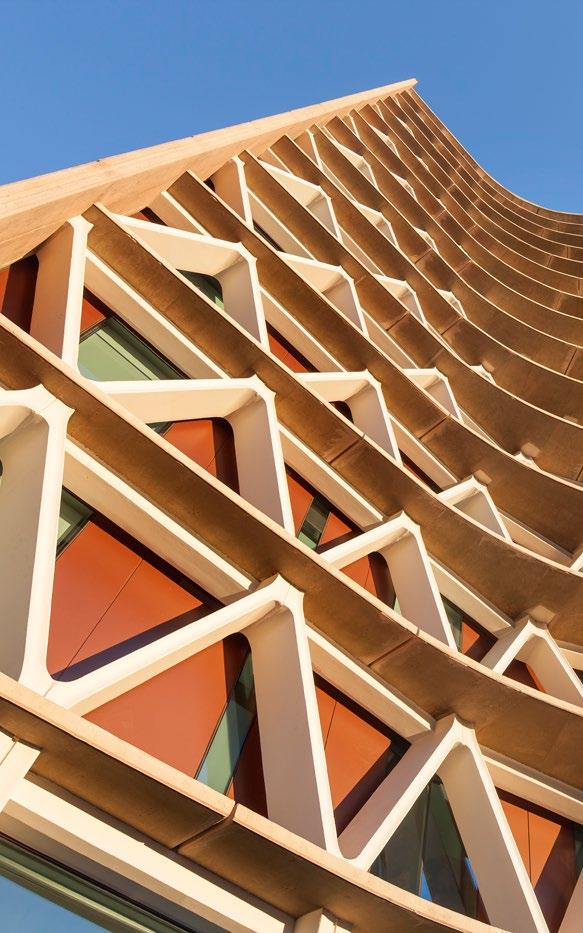
Client: American Campus Communities, Arizona State University
Location: Tempe, AZ
Size: 211,000 SF
Originally designed in 1967, the 15-story Manzanita Hall was the tallest building in Arizona when it opened. With its unique geometric exterior design, the dormitory immediately became an icon on the Arizona State campus. However, after over 40 years of housing more than 40,000 students, the residence hall was in poor condition and no longer served student needs. ASU hired SCB to conduct a feasibility study to explore renovation or replacement strategies for the 810bed residence hall. The study revealed that replacement would be a far easier undertaking; however, the University ultimately decided to renovate the building due to its iconic character and the importance of its place in the memories of alumni. ASU retained SCB and Studio Ma to work with American Campus Communities to complete a full renovation of Manzanita Hall.

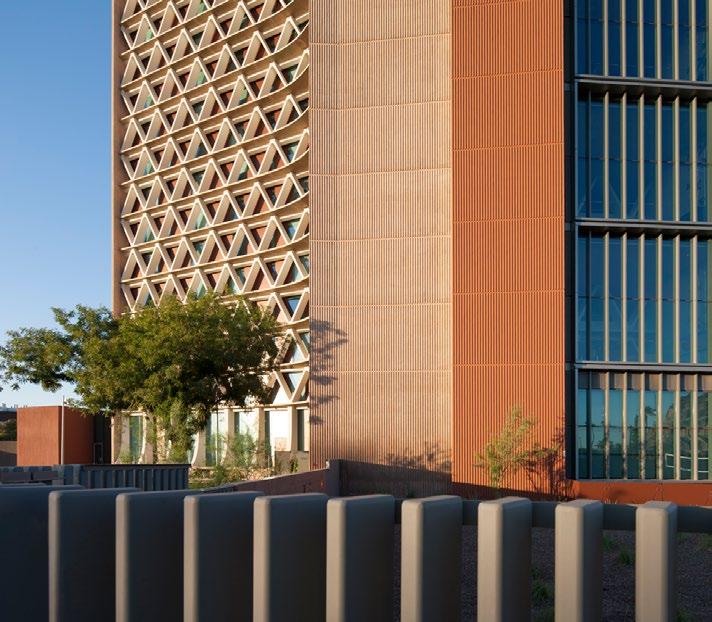
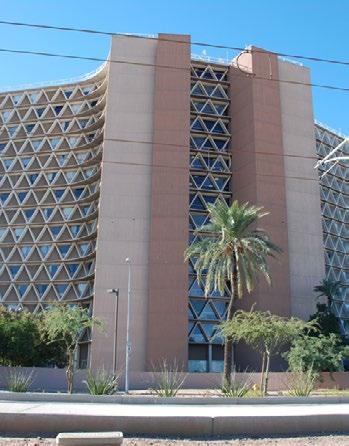
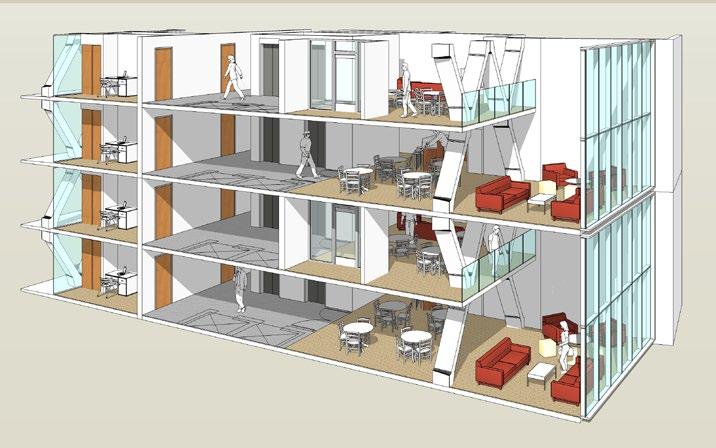
The renovation sought to improve physical and social connections, increase natural light into the building, and integrate technologies for today’s increasingly connected students. The design team found an opportunity to add two-story communal lounges and kitchens within new “found space” by extending the original northwest exterior wall to the L-shaped shear walls and adding floor-to-ceiling glass. The original exterior bracing is now part of the interior, demarcating each lounge’s mezzanine.
Working within the constraints of the existing building, the design team reconfigured the floor plans to accommodate a more efficient layout, consisting of semi-suites composed of two double-occupancy rooms with a shared bathroom. Significant physical surveying and space planning ensured that the new floor layouts for suites and bathrooms did BEFORE
not interfere with the building’s existing structural elements. The planning for the new plumbing chases faced challenges due to existing post-tension slabs and interior shear walls, which could not be eliminated or encroached upon. The decision to reuse the building established the University’s commitment to sustainability, which became a priority for the project. Manzanita Hall achieved LEED Silver.
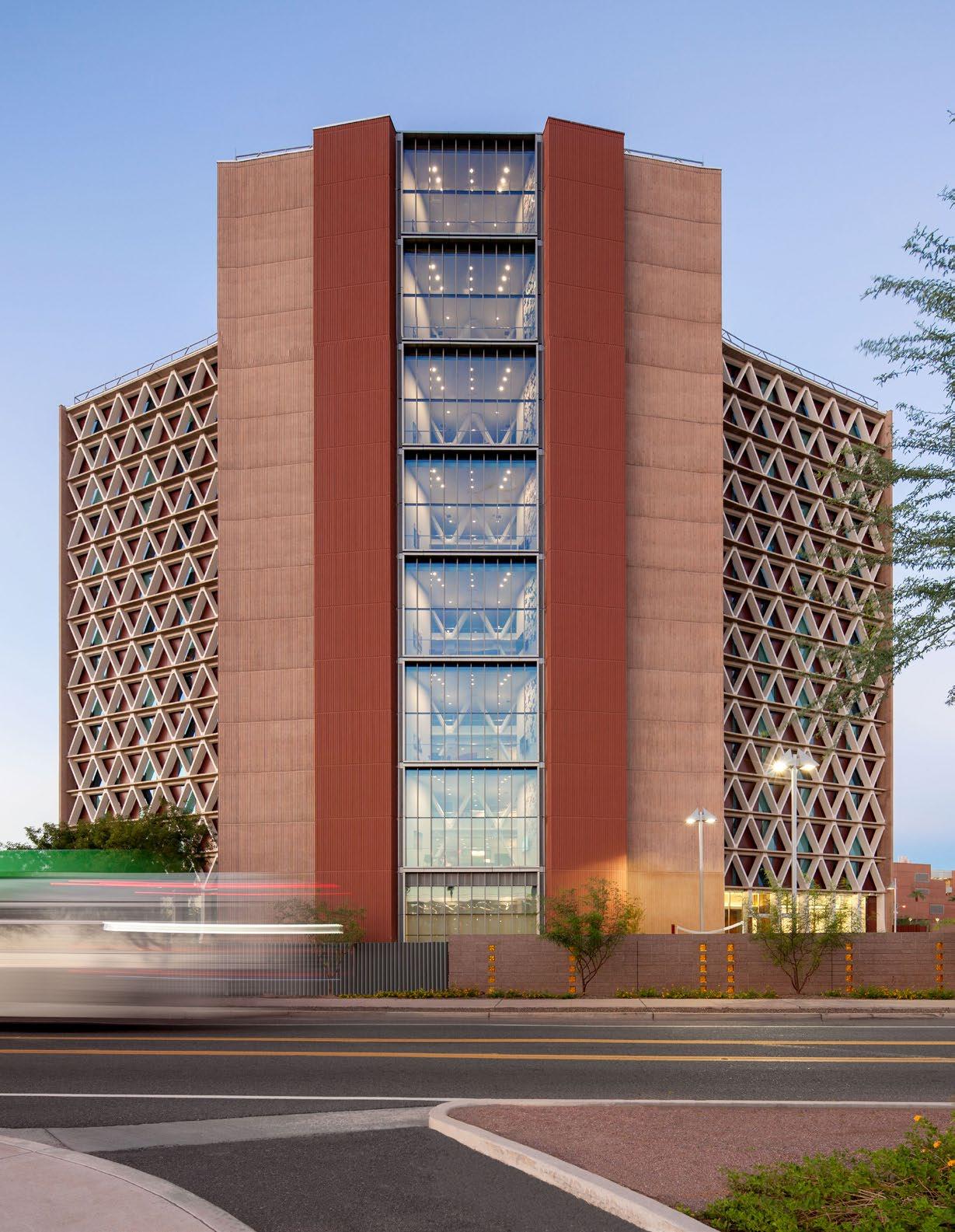
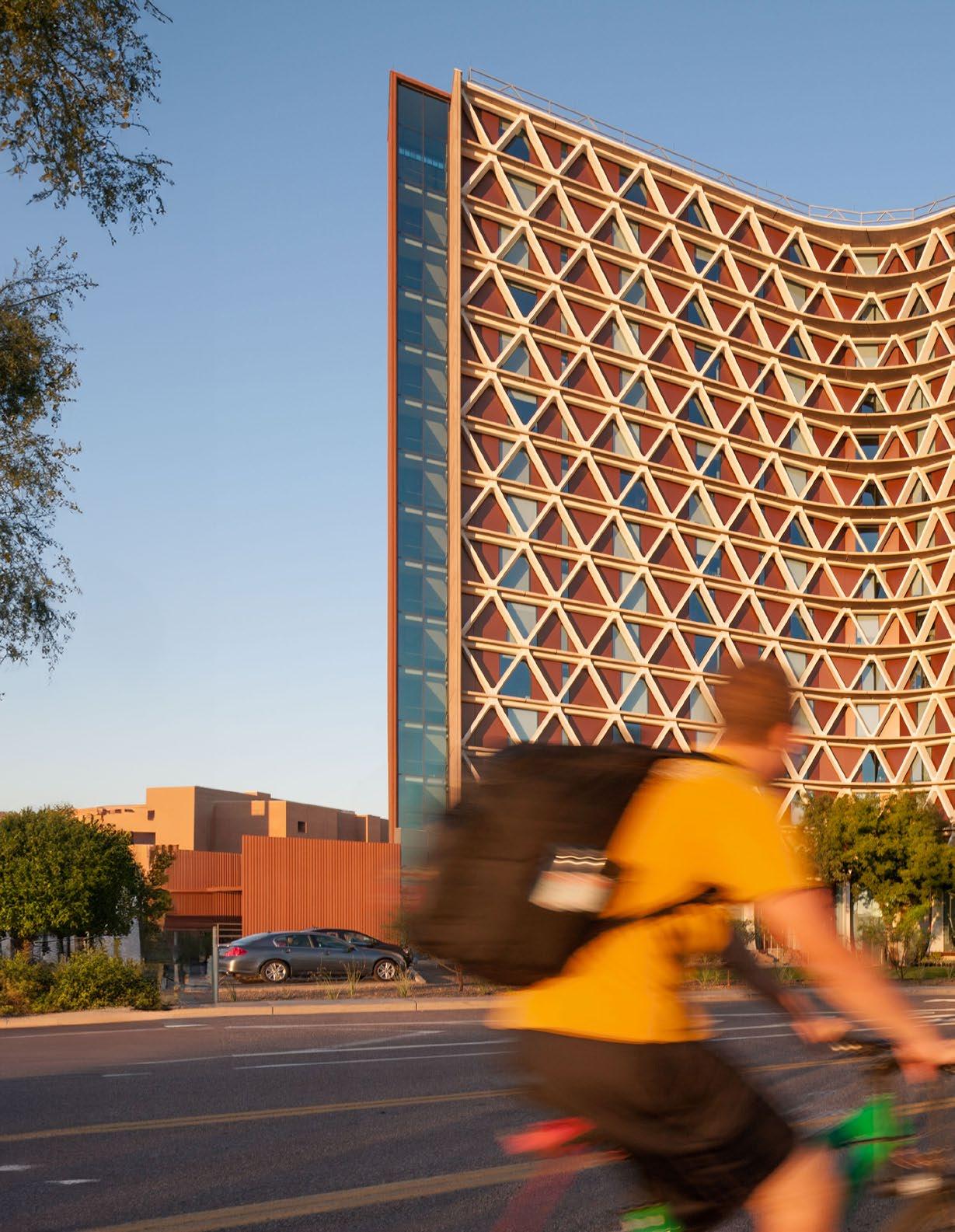
“THIS WAS A FOREBODING TECHNICAL REDEVELOPMENT OF A STRUCTURE THAT PROBABLY SHOULD HAVE BEEN DEMOLISHED.
EVERYONE ON THE PLANNING TEAM WAS PETRIFIED OF THE RISKS AND UNFORESEEN ASSOCIATED WITH THE BUILDING.
THE SCB TEAM WAS CREATIVE, PIONEERING AND THOROUGH, AND LED AN AMAZING PROJECT TEAM. THE PROJECT WAS DELIVERED ON TIME, UNDER BUDGET AND 100 PERCENT LEASED.”
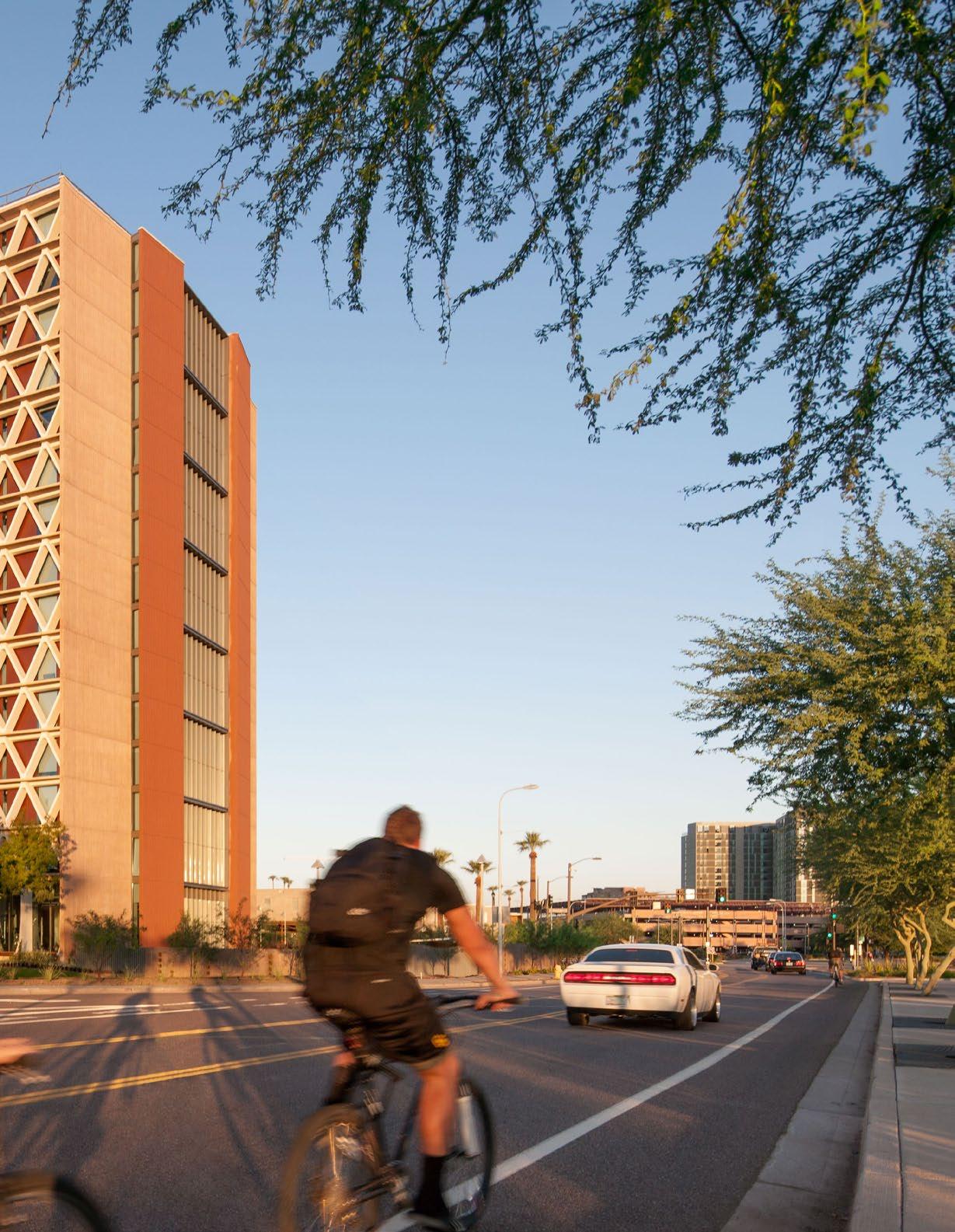
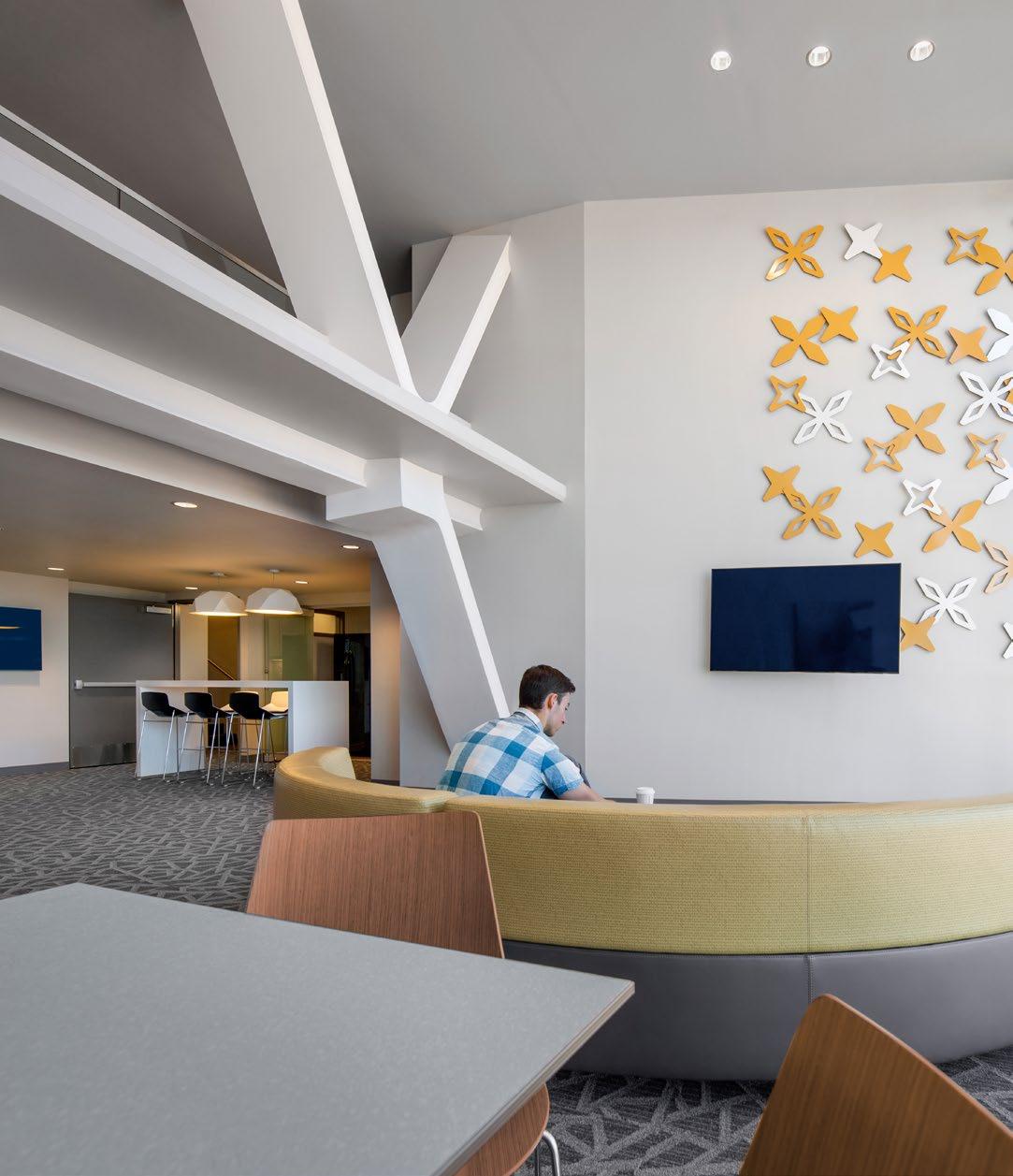

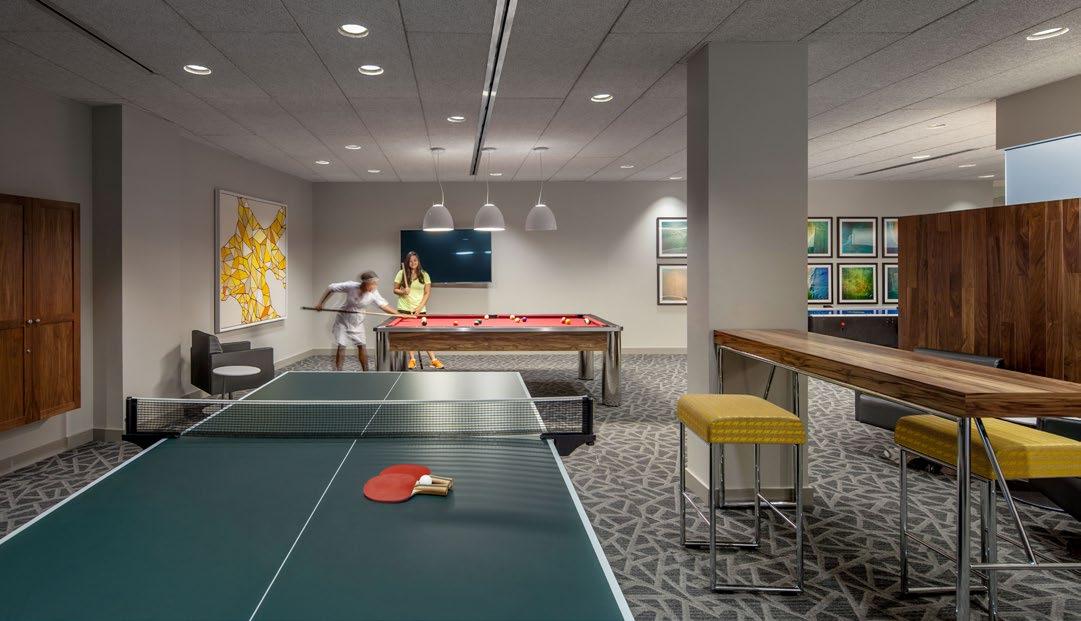
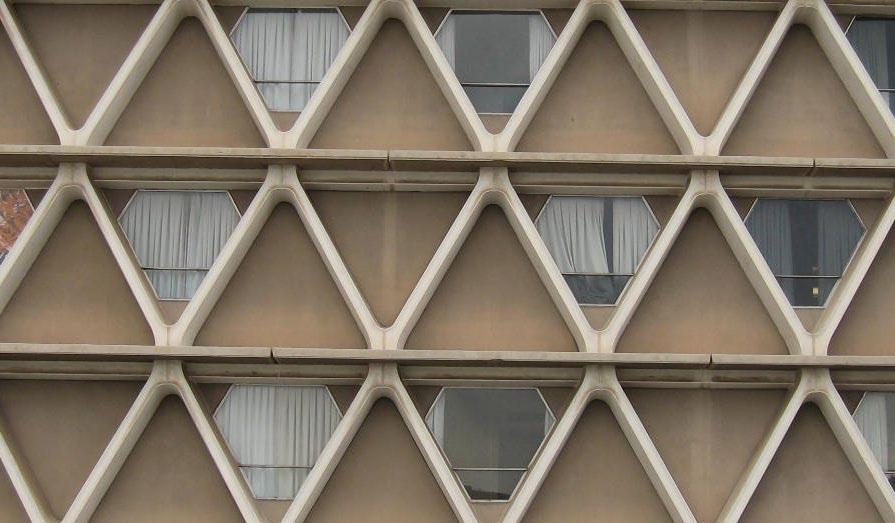

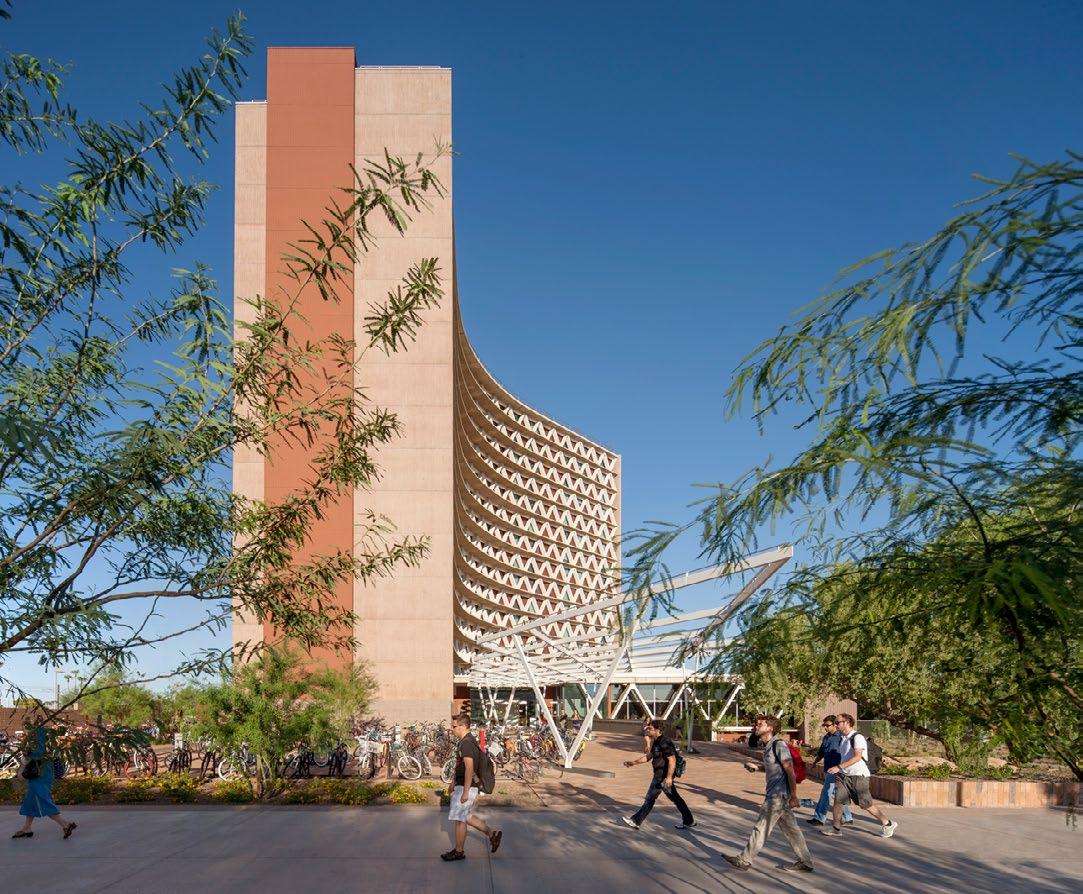
The new building envelope was designed to work with the existing structural bracing system expressed on the exterior of the building. By eliminating the existing infill windows and wall panels and setting the new exterior wall behind the structural braces, the design team visually accented the iconic braces, giving the building a more crisp graphic character. This solution also allowed for the new enclosure to run uninterrupted behind the braces and consequently perform at a higher thermal efficiency.
AWARDS: SCUP/AIA-CAE Excellence in Architecture for Restoration or Preservation Honor Award
AIA Arizona Distinguished Building Honor Award
Student Housing Business Innovator Award, On-Campus: Best Renovation of Existing Dorm
Criteria is scored on a scale of one to ten, with one representing poor and ten representing excellent.
NAME Bentley Hall OUTCOME Renovation + Addition
10.0
MASTER PLAN
Located within an established campus residential district. Additional capacity on site to accommodate a new addition.
7.0
STRUCTURE AND ENCLOSURE
Solid concrete structure and well-performing enclosure. Window replacement needed.
5.0
BUILDING SYSTEMS
Full replacement of bathrooms and plumbing needed. Potential for strategic reuse and/or replacement of HVAC for units.
7.0
FLOOR PLANS
Acceptable unit type and size. Potential for significant upgrades to existing amenity space, as well as new addition for additional programmed space.
COST AND VALUE
Cost of renovation significantly less than comparable new construction. Offset cost for new addition. 10.0
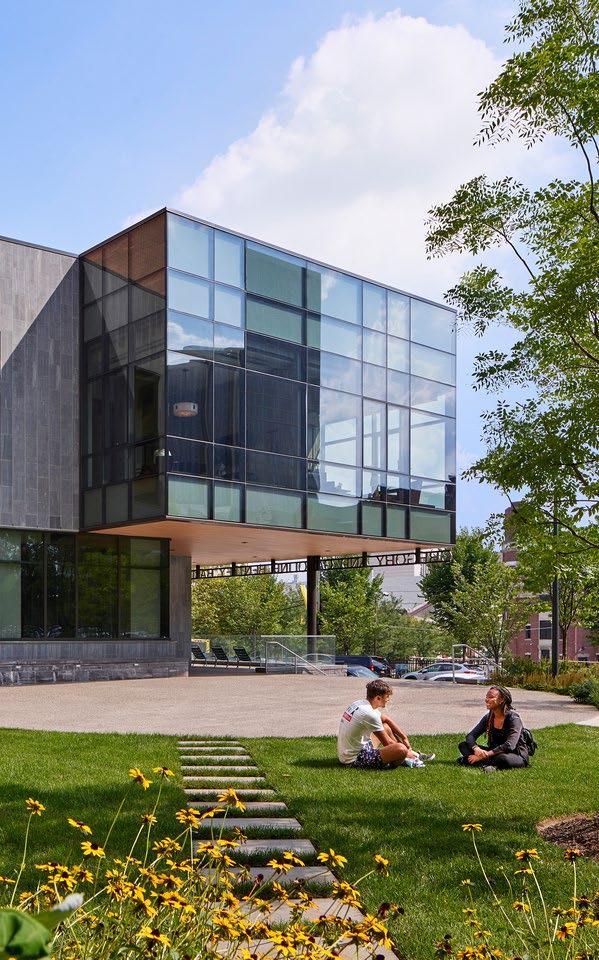
Client: Drexel University
Location: Philadelphia, PA
Size: 94,000 SF, 406 beds (Renovation) 11,000 SF (Addition)
Originally constructed in 1969, Bentley Hall at Drexel University typified a common challenge faced by many universities: a large, in this case 406-bed, residence hall that was outdated and no longer serving the needs of students. SCB was selected as the architect and interior designer for a full renovation of the existing Bentley Hall and an 11,000-square-foot academic addition to serve as the new home for the Pennoni Honors College.
Renovations of the original Bentley Hall included a full building systems update and complete remodeling of the student residential units and bathrooms. Lounges adjacent to the elevators were added to each floor, and alternate between social and study uses to help build a sense of community amongst residents.
The ground floor was reimagined and connects seamlessly to the addition, which houses three seminar rooms, quiet study space, and a “living room” for the honors college. This rich, programmatic mix provides abundant options for students and faculty to gather.

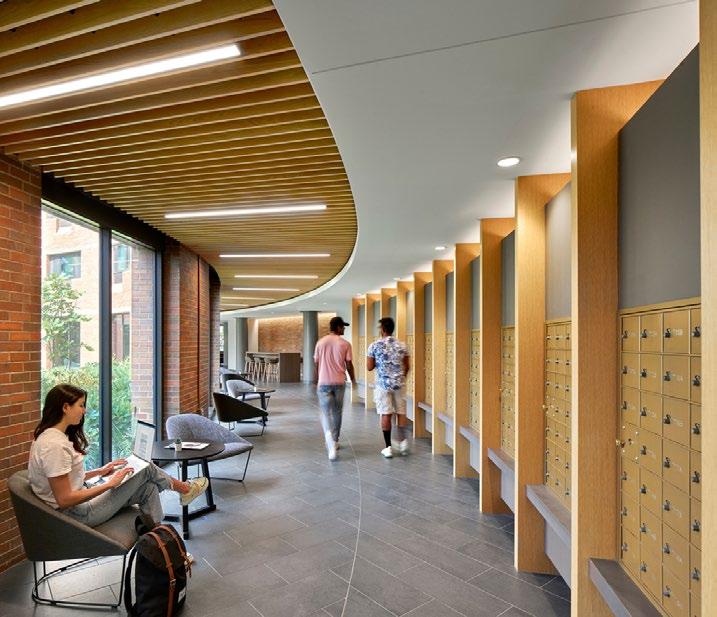

THE INTERIOR DESIGN FOR THE SPACE TAKES CUES FROM THE ORIGINAL MID-CENTURY VINTAGE OF BENTLEY HALL INCLUDING EXPOSED BRICK WALLS, MODERN FURNITURE, AND LIGHTING INSPIRED BY THE ERA.

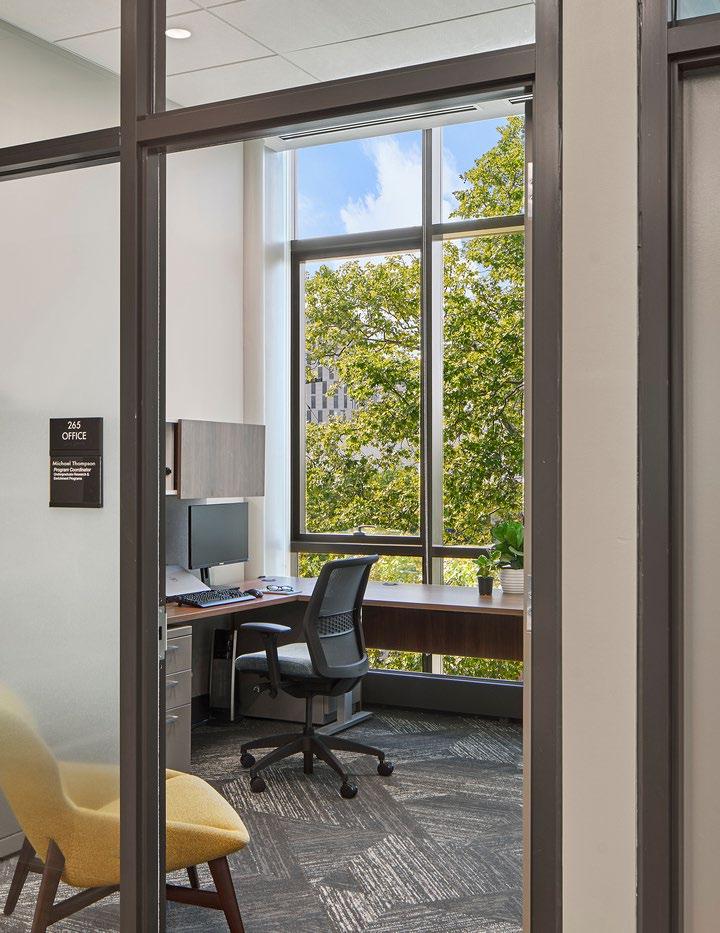
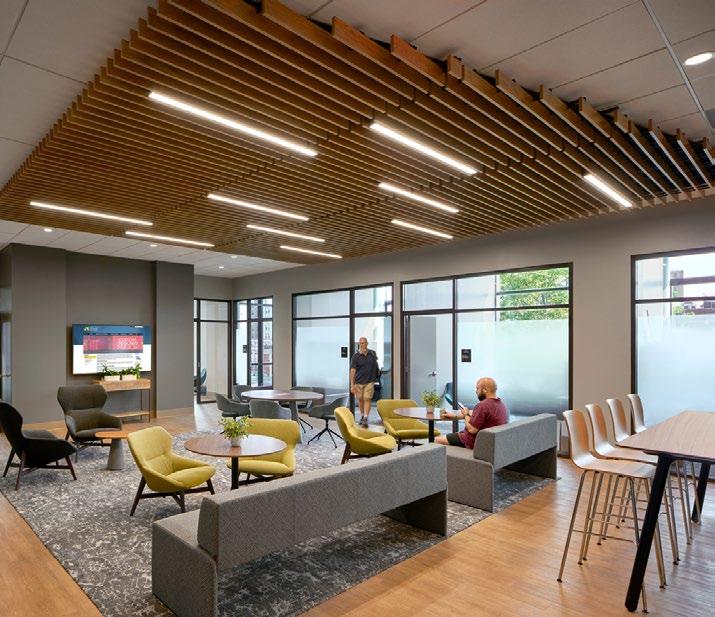
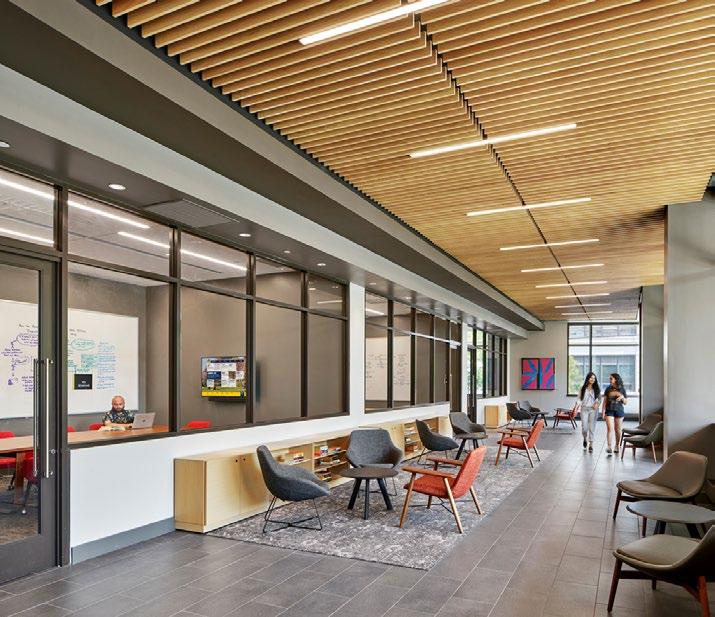
The new addition provides the Honors College with a new identity and is differentiated from the larger Bentley Hall through a modern stone and glass architectural expression. A front porch extending the length of the addition enlivens the Arch Street façade with outdoor seating and an unobstructed visual connection to the interior spaces. The second floor houses a suite of offices for faculty and Honors College staff, organized around a central shared lounge.
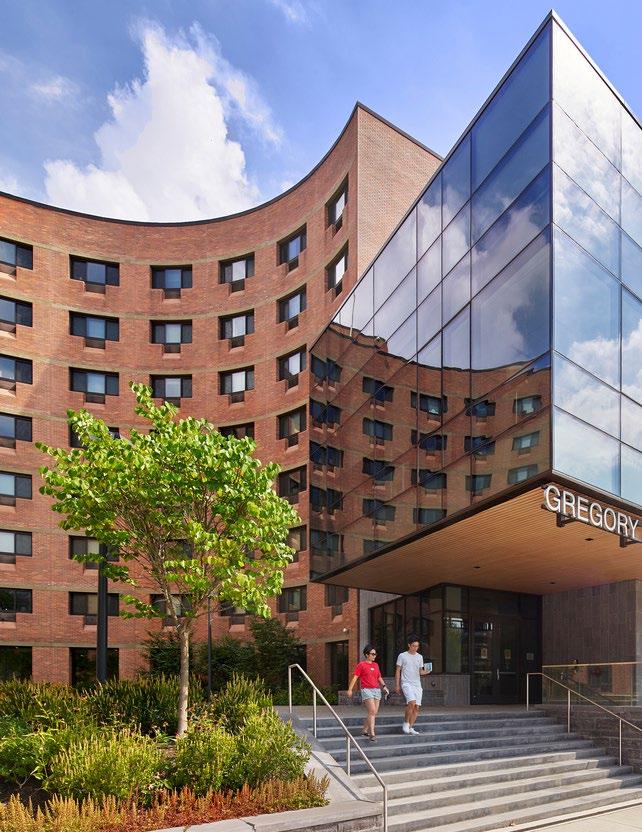
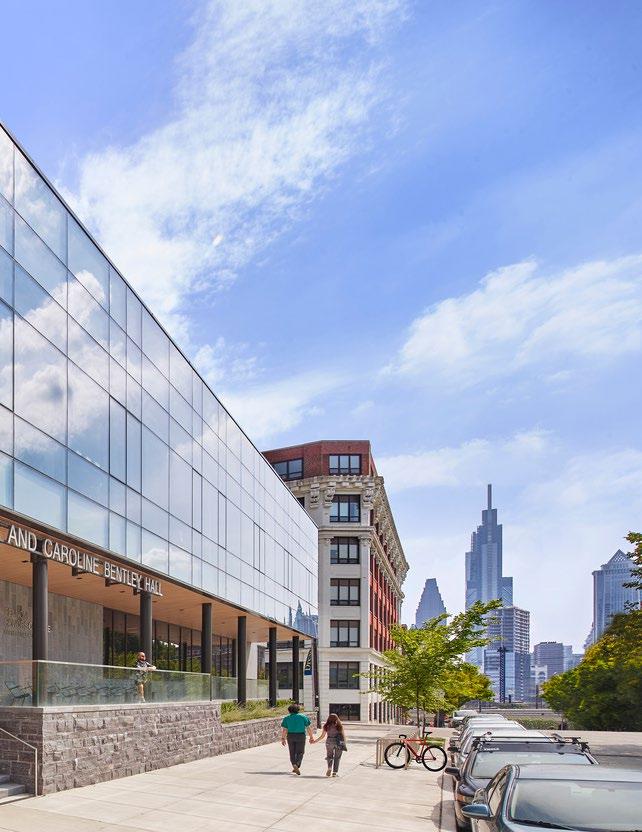
PROJECT EVALUATION
Criteria is scored on a scale of one to ten, with one representing poor and ten representing excellent.
NAME Elder Hall
OUTCOME Renovation + Addition
MASTER PLAN
Located in proximity of other residence halls and Greek housing along the campus’ main thoroughfare.
9.0
9.5 STRUCTURE AND ENCLOSURE
Solid concrete structure and reasonably well performing enclosure.
7.5 FLOOR PLANS
BUILDING SYSTEMS
Feasible to keep window AC units in student rooms with local climate and add central AC to all amenity spaces.
7.0
Limited amenities (aside from dining), but potential for new addition to add community spaces on all floors.
8.5
COST AND VALUE
Cost for renovation and addition considerably less than replacement/ new construction.
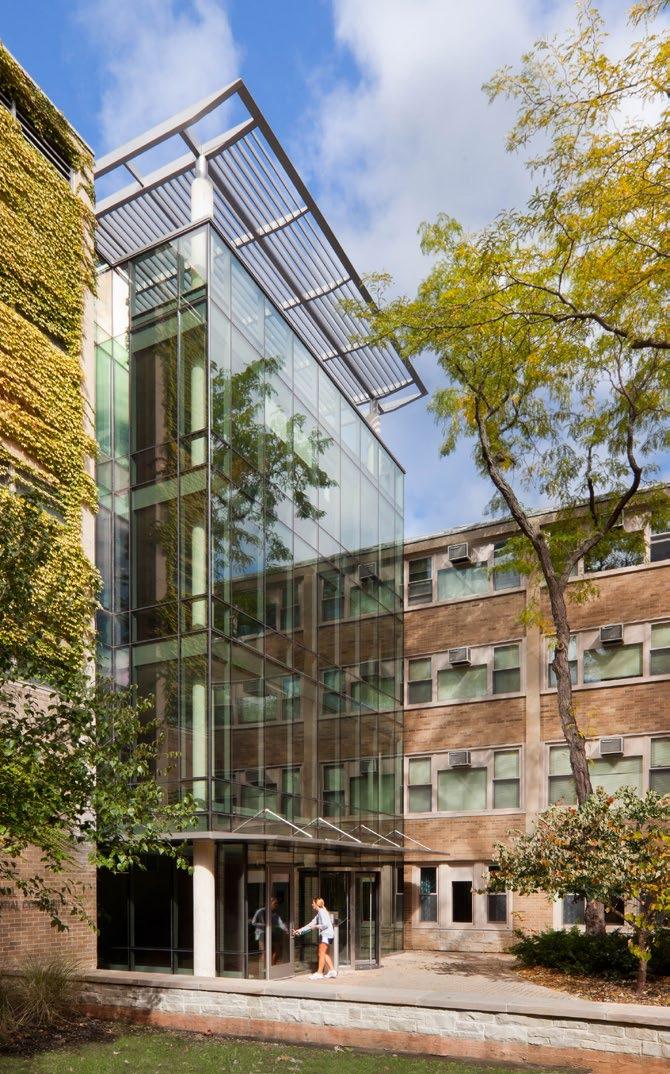
Client: Northwestern University
Location: Evanston, IL
Size: 19,000 SF Renovation, 5,000 SF Addition
Two existing residence halls on the Northwestern University campus were adjacent to each other, but not equal. Elder Hall, designed by Holabird, Root and Burgee in 1959, had a central dining center and a variety of amenities. The smaller 600/610 Lincoln Hall, also constructed in 1959, was converted to a co-ed residence hall in 1976 after serving as the home of Tau Delta Phi fraternity. 600/610 Lincoln Hall offered limited amenities to its residents.
After evaluating the program needs and existing amenities within each hall, SCB proposed building an addition to connect the two structures and create one larger residential community. Nestled into a formerly underutilized courtyard, the modern, light-filled “link” integrates the two existing structures and serves as an inviting central entry point to the new Elder Hall. At night, the structure glows with light from within to animate the landscaped entry courtyard.
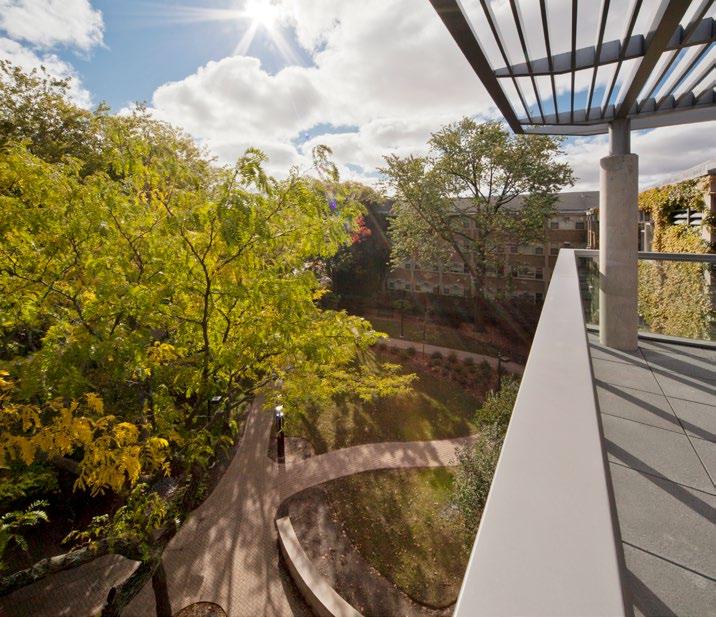


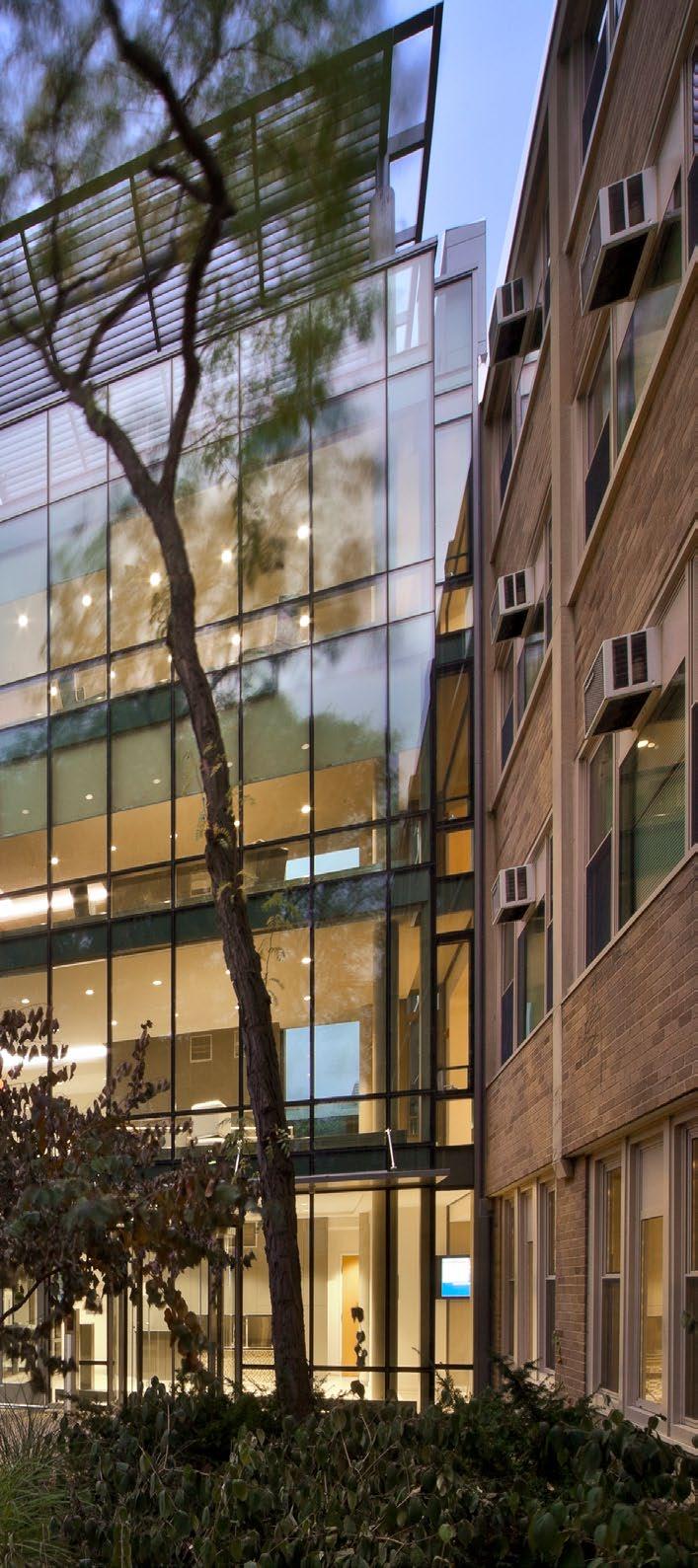
The Elephant on Campus Elder Hall
Beyond providing practical circulation between the residences, the addition also offers small seating areas on each level for spontaneous interactions between students or for quiet contemplation and study. A new elevator within the addition provides access to each residential floor. On the top level, a new rooftop terrace offers panoramic views of the campus and Lake Michigan.
The existing shared spaces within each of the buildings were enhanced and redesigned. Additionally, new recreation and multi-purpose spaces were designed to support student life, as well as provide the entire complex with a new identity.
PROJECT EVALUATION
Criteria is scored on a scale of one to ten, with one representing poor and ten representing excellent.
PLAN Located within a campus residential district.
5.0
9.5 STRUCTURE AND ENCLOSURE Solid concrete structure, inefficient and low-performing enclosure.
3.0 FLOOR PLANS
SYSTEMS Full replacement needed.
3.5 COST AND VALUE
Bifurcated building circulation, limited amenity space, and poor location of shared bathrooms makes reconfiguration difficult.
Comparable cost for renovation versus new construction, but loss of efficiency with new construction. 9.0 NAME Studebaker East
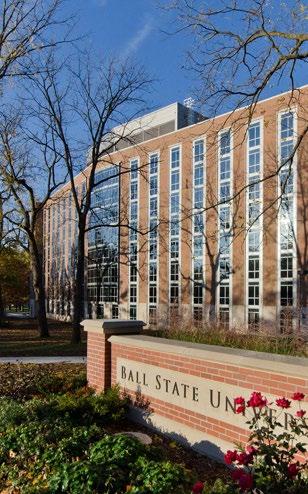
Client: Ball State University
Location: Muncie, IN
Size: 74,000 SF
At Ball State University, the enclosure of Studebaker East, designed by Walter Scholer & Associates in 1965, was failing and needed replacement; however, the structure of the building remained sound. The building was accessible through two separate entrances: one with access to floors one through five and the other providing elevators to floors six and above. The overall organization of the building essentially created two separate vertical housing sections. After an extensive investigation, SCB, along with Schmidt Associates as Architect of Record, determined that the structure could be economically renovated and redesigned to meet the current campus’ needs.

AFTER AN EXTENSIVE INVESTIGATION, IT WAS DETERMINED THAT STUDEBAKER EAST COULD BE ECONOMICALLY RENOVATED AND REDESIGNED TO MEET THE CAMPUS’ EVOLVING NEEDS.
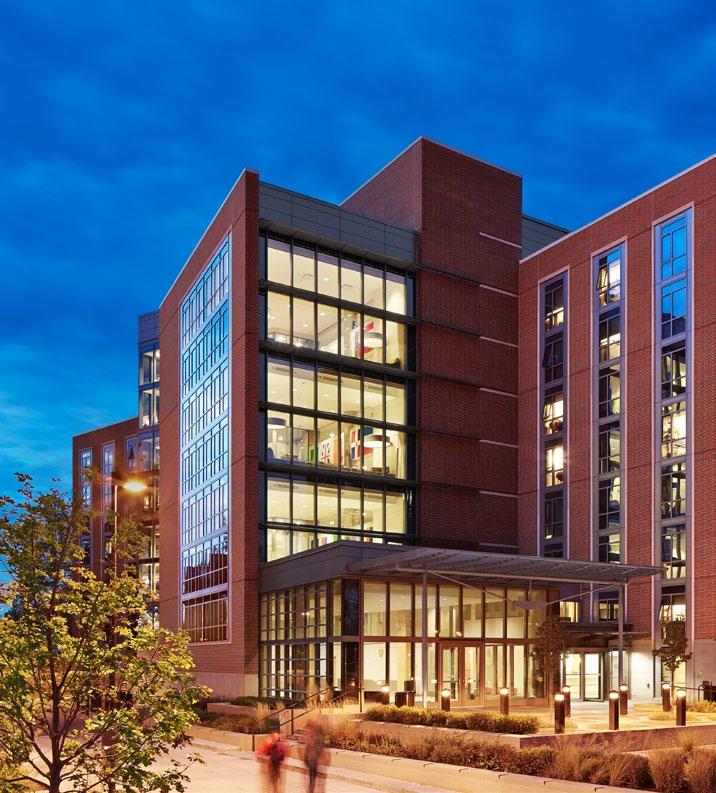
Through the study of circulation patterns and view corridors, it was determined that the primary focus of activity was at the southwest corner of the building. The existing community bathrooms located at this point were demolished and relocated to make way for a new, stacked twostory lounge addition and main entrance. By using the existing building’s form and material vocabulary, the addition seamlessly connected to both the original structure and overall campus design. The new entry was raised above grade level to allow for a green plaza and landscaped terraces. At the ground level, a two-story, multi-purpose room was added to serve as the main community destination in the building. Above, a series of two-story communal lounges, equipped with kitchen spaces on alternate floors, enhances social connectivity between floors.
On the residential floors, SCB maintained the existing room layout with a central the existing room layout with a central corridor to each wing. Moveable and stackable furniture allows students flexibility to personalize the rooms to suit their needs. A radiant heating and cooling valance system was incorporated into the student rooms as a non-invasive way of incorporating new low-energy environmental systems. The building is LEED Gold.

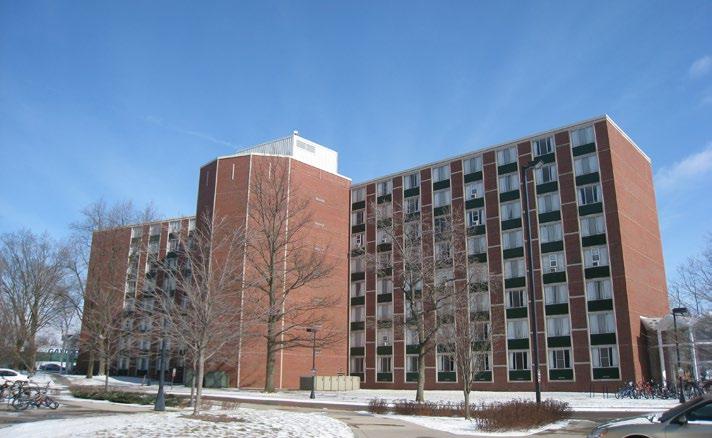

PROJECT EVALUATION
Criteria is scored on a scale of one to ten, with one representing poor and ten representing excellent. MASTER PLAN
5.0
Located within a campus residential district and adjacent to student union, but poor site utilization.
7.0 BUILDING SYSTEMS Full replacement needed.
STRUCTURE AND ENCLOSURE
Solid concrete structure, inefficient and low-performing enclosure.
3.0 FLOOR PLANS
2.0 COST AND VALUE
3.5 NAME Irvington House OUTCOME Renovation
Limited amenities, significant ADA issues, and inefficient floor plates too narrow to accommodate residential units comparable to new builds.
Comparable cost for renovation and new construction, but no solution to programmatic shortfalls.
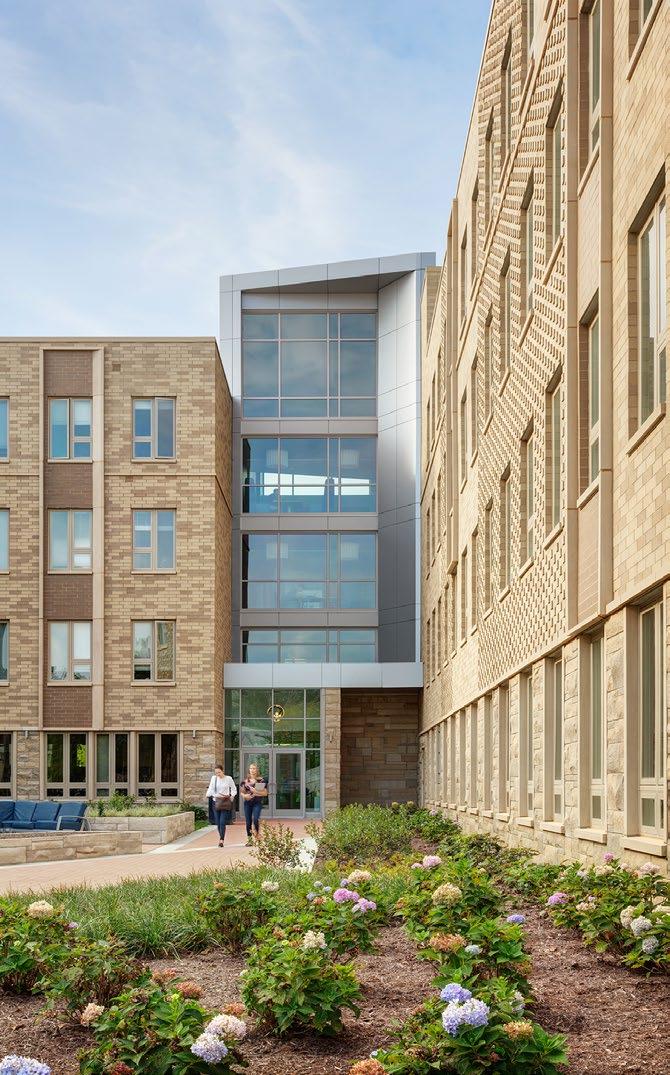
Client: Butler University and American Campus Communities
Location: Indianapolis, IN
Size: 183,000 SF, 647 beds
Schwitzer Hall was built in 1956 as a women’s dormitory at Butler University. The three-story, 450-bed collegiate gothic building enjoyed a large front lawn along Hampton Drive and was located next to the Atherton Hall, Butler’s student union. SCB was engaged to complete a feasibility study to explore whether the University and their development partner should renovate or replace the aging facility.
The building posed a variety of challenges for renovation. Its siting with its generous lawn was not the best utilization of land, its mechanical systems had reached end of their life cycle, low floor-to-ceiling heights and narrow floor plates offered no planning flexibility, and the building had significant ADA issues. After a thorough investigation of the building’s structure, systems, program and floor plans, it was determined that replacement would yield the University the best value, both in terms of budget and their campus residential experience. The building was demolished and Irvington House was built on the site.
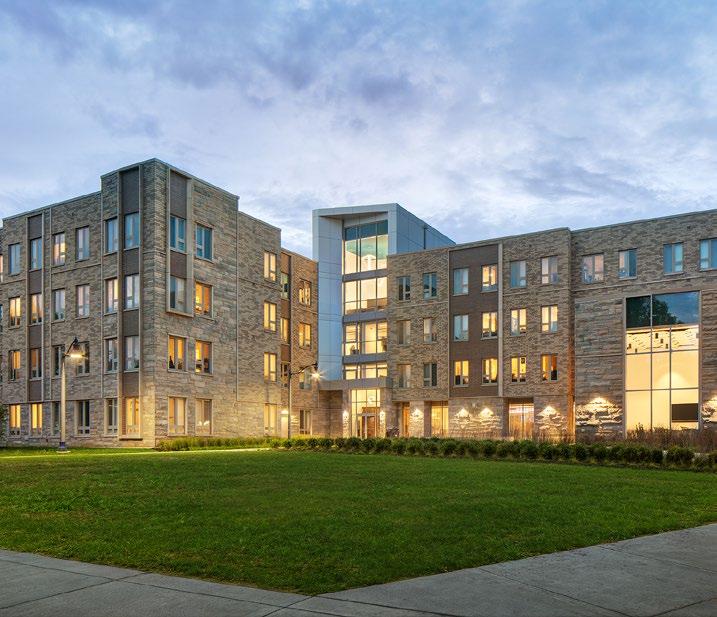


FUTURE ACADEMIC BUILDING FOOTPRINT
RESIDENTIAL COLLEGE ALIGNMENT
ATHERTON ALIGNMENT


ATHERTON HALL
RESIDENTIAL COLLEGE
The new 183,000-square-foot freshman residence hall was re-sited closer to Hampton Drive, preserving a significant parcel of land for future use. The building offers 647 beds (30 percent more than Schwitzer Hall) organized in semi-suites. Shared community amenities include social lounges, group study rooms, a fitness center, communal kitchen, and an indoor bike room.
A large, ground floor multi-purpose room supports student organizations, Greek chapters, and other campus programming. Two faculty-in-residence apartments provide residents the opportunity for enhanced academic engagement.
The design presents a modern complement to the collegiate gothic campus aesthetic while respecting the materiality of campus through its use of brick and limestone. A pair of large campus-facing courtyards provide two distinct outdoor programs: one more social with a fire pit and ample lounge seating and one designed as a quiet, contemplative space. The siting and massing of the building were developed to optimize solar orientation and mitigate heat gain, as well as maximizing opportunities for daylighting within the building. Irvington House is LEED Gold.
PROJECT EVALUATION
Criteria is scored on a scale of one to ten, with one representing poor and ten representing excellent.
Renovation + Addition
10.0
MASTER PLAN
6.0
7.0
8.0
Located within an established campus residential district. Additional capacity on site to accommodate a new addition.
STRUCTURE AND ENCLOSURE
Solid concrete structure and well-performing enclosure. Window and masonry lintel replacement needed in student rooms as well as curtain wall at floor lounges.
BUILDING SYSTEMS
Full replacement of bathrooms and plumbing needed. Potential for strategic reuse and/or replacement of HVAC for units.
FLOOR PLANS
Cost of renovation significantly less than comparable new construction. Offset cost for new addition. 10.0 NAME Kelly Hall
Acceptable unit type and size. Potential for significant upgrades to existing amenity space, and a new addition for additional indoor and outdoor programmed spaces.
COST AND VALUE
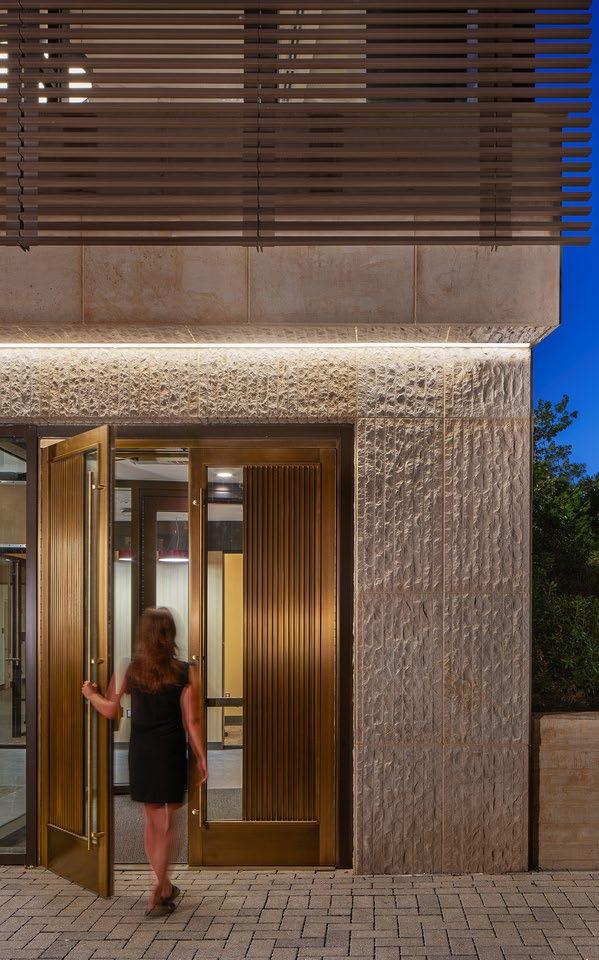
Client: Drexel University and American Campus Communities
Location: Philadelphia, PA
Size: 84,000 SF
Kelly Hall is a case study in how a small, strategic addition can revitalize a whole residential community. Originally constructed in 1967, the 11-story residential tower was designed by Baader, Young, & Schultze. The renovation included a full restoration of the masonry façade, replacement of all windows, and upgrades to all building systems.
The original building basement provided space for student amenities but was dark and hidden from view. By taking advantage of the grade change along the site the design team excavated the lower level, opening the space to natural light. A small 4,000 square-foot addition extends the floor plates of the original ground level and lower level and allows for the creation of a new academic success center, which is open to the full campus community.
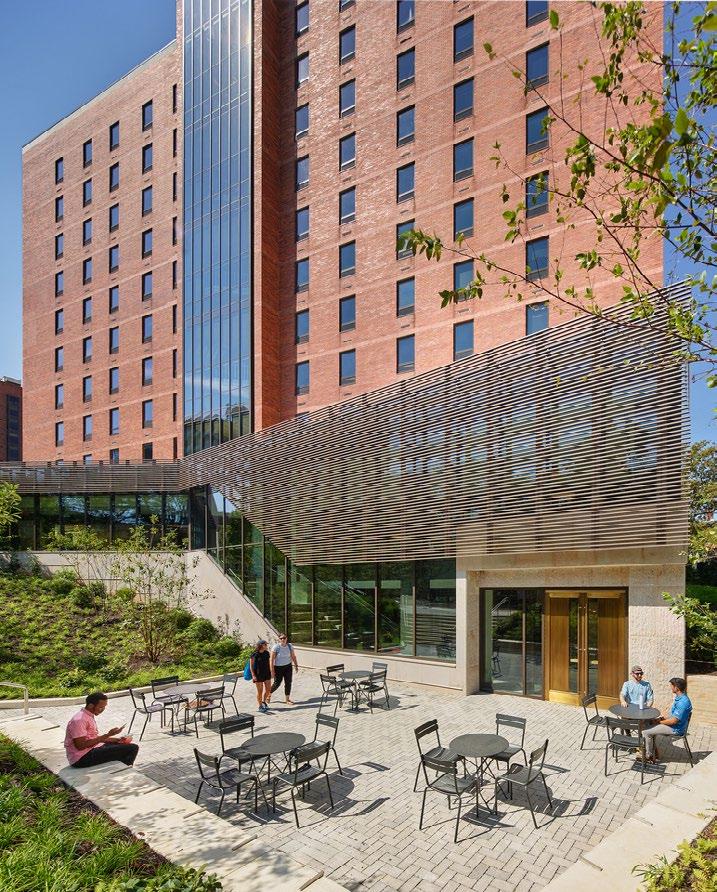
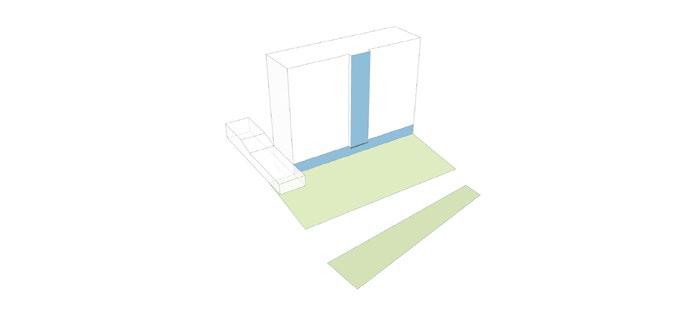

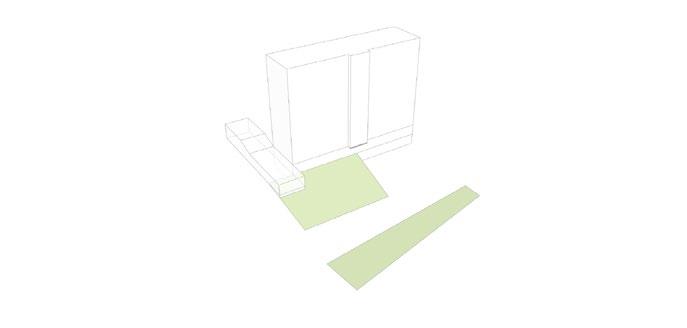
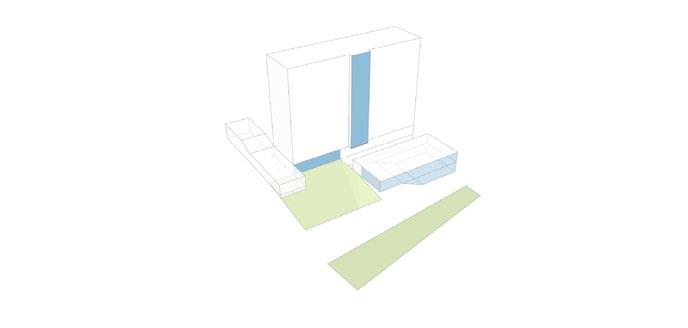
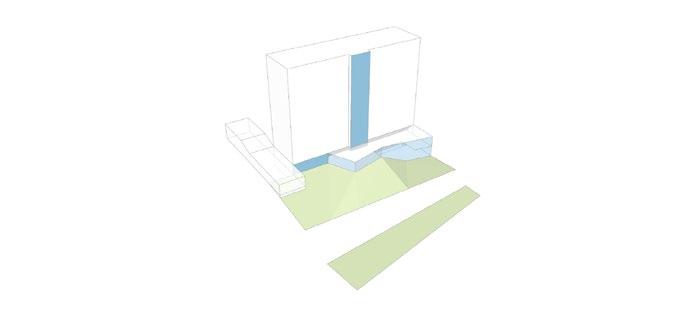
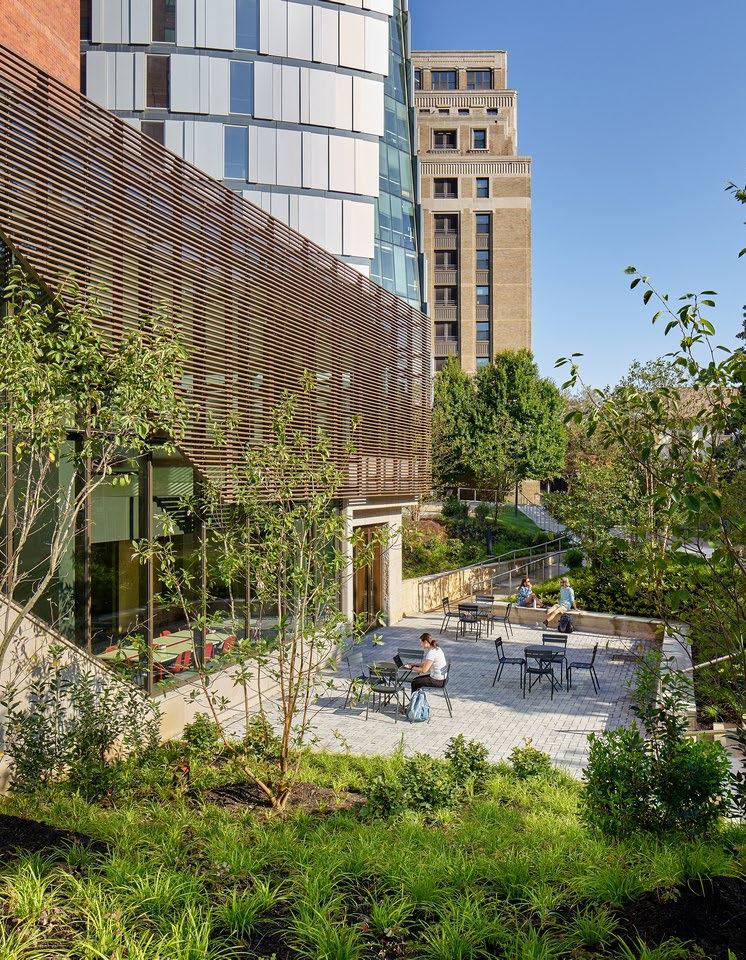
A fully glazed double height atrium which features a monumental communicating stair, is linked to a new landscaped outdoor plaza. Academic-focused amenities include larger informal collaborative areas, along with small group meeting rooms and individual study spaces.
The original main entrance to the building remains, now becoming a secure point of entry for residents only. The exterior design of the addition works within the material dialogue of Kelly Hall, utilizing regionally sourced stone and taking cues from the implied lines and geometries within the existing building. A screening element serves dual purposes mitigating thermal gain and solar glare, while also helping to prevent bird strike.
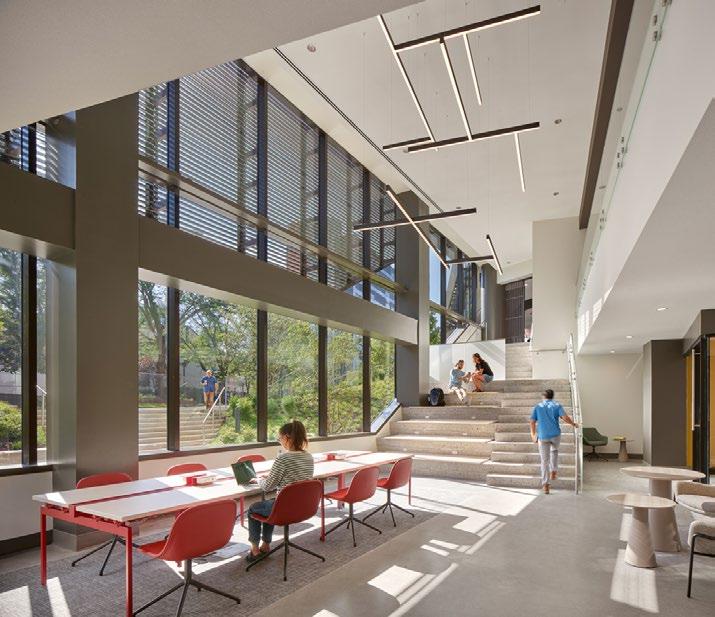

Kelly Hall and Commons
Inside, minimal alterations were made to the residential floorplans; the 410 beds were maintained as traditional doubleoccupancy rooms, while the existing shared community bathrooms were updated to offer private shower and toilet stalls. The residential floors are linked through a series of central, twostory social lounges. Here, the design team took the opportunity to celebrate these communal spaces by replacing the masonry façade with a glass curtainwall, as well as opening visual access to the lounges from the interior through the use of glazing, allowing daylight into the primary circulation path on each floor.
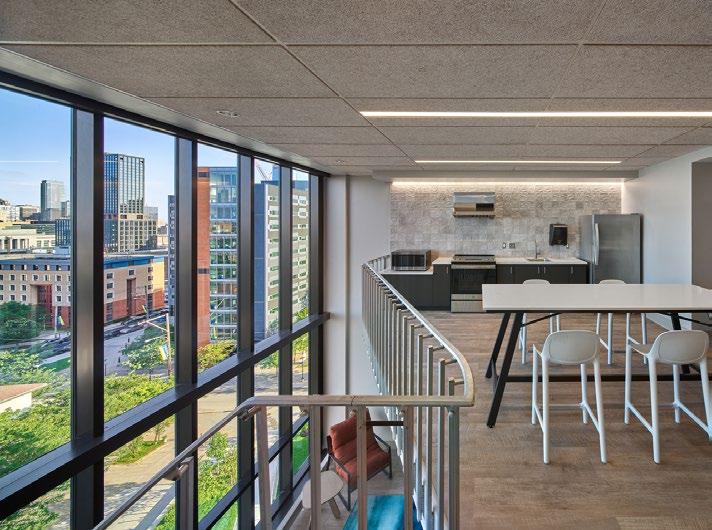


PROJECT EVALUATION
Criteria is scored on a scale of one to ten, with one representing poor and ten representing excellent.
PLAN Located within an established campus residential district. 10.0 STRUCTURE AND ENCLOSURE
Solid concrete structure and wellperforming enclosure. Window replacement needed. 7.0
Acceptable unit type and size. Potential for significant upgrades to existing amenity spaces, including dining hall. 7.0 COST AND VALUE
Cost of renovation significantly less than comparable new construction. 10.0

Client: Butler University
Location: Indianapolis, IN
Size: 158,000 SF, 413 beds;
Dining: 23,000 SF, 250 seats
Residential College (ResCo) is a first-year residence hall and dining facility at Butler University. As part of a multi-phased transformation of its campus residential experience, including two new residence halls designed by SCB, Butler re-engaged the firm to complete a full renovation of ResCo, the building’s first since its completion in 1989, to bring it up to par with the newer residential and dining offerings on campus.
The 413-bed community was updated with new finishes and furniture throughout, including residential units, bathrooms, and corridors. Amenity spaces throughout the residential floors were re-programmed to offer each floor three distinct spaces; a social lounge, dedicated quiet study room, and a hybrid space for group work. Larger community spaces on the ground floor and second floor of the building were also completely renovated, upgrading the social and study spaces, as well as meeting rooms and offices. Replacing solid walls with glass and creating perimeter study rooms increased natural light within the interior spaces, reducing the need for supplemental lighting, and adding spaces to accommodate diverse study preferences and needs. Extensive materials research identified fabrics and finishes that met institutional performance needs but looked and felt more soft and residential in nature.
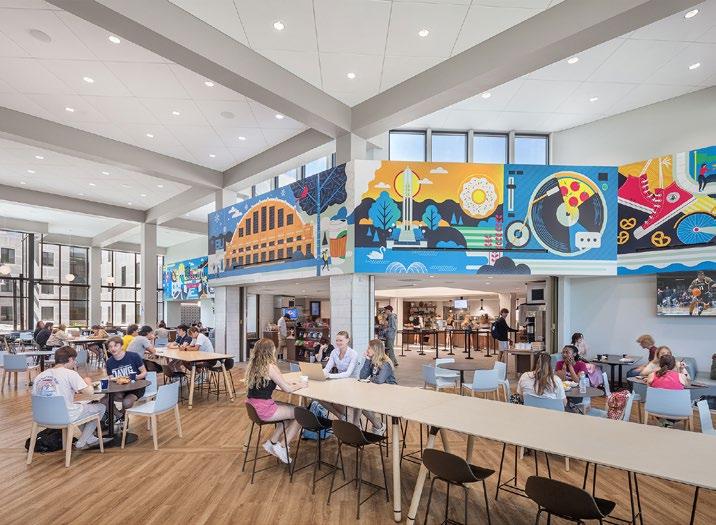
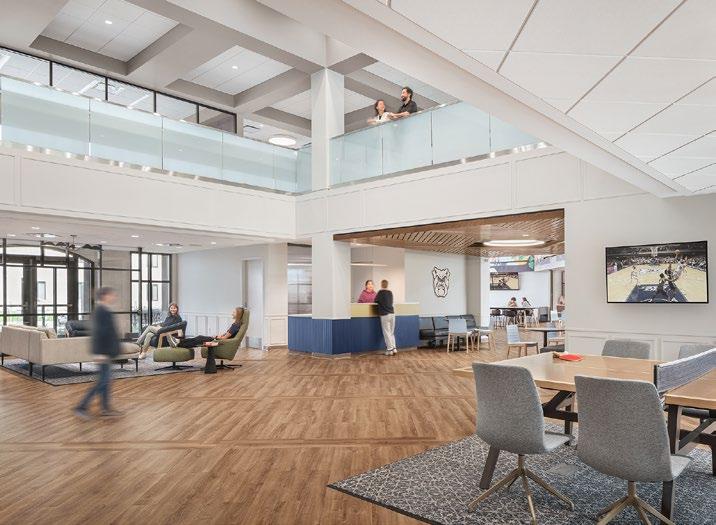
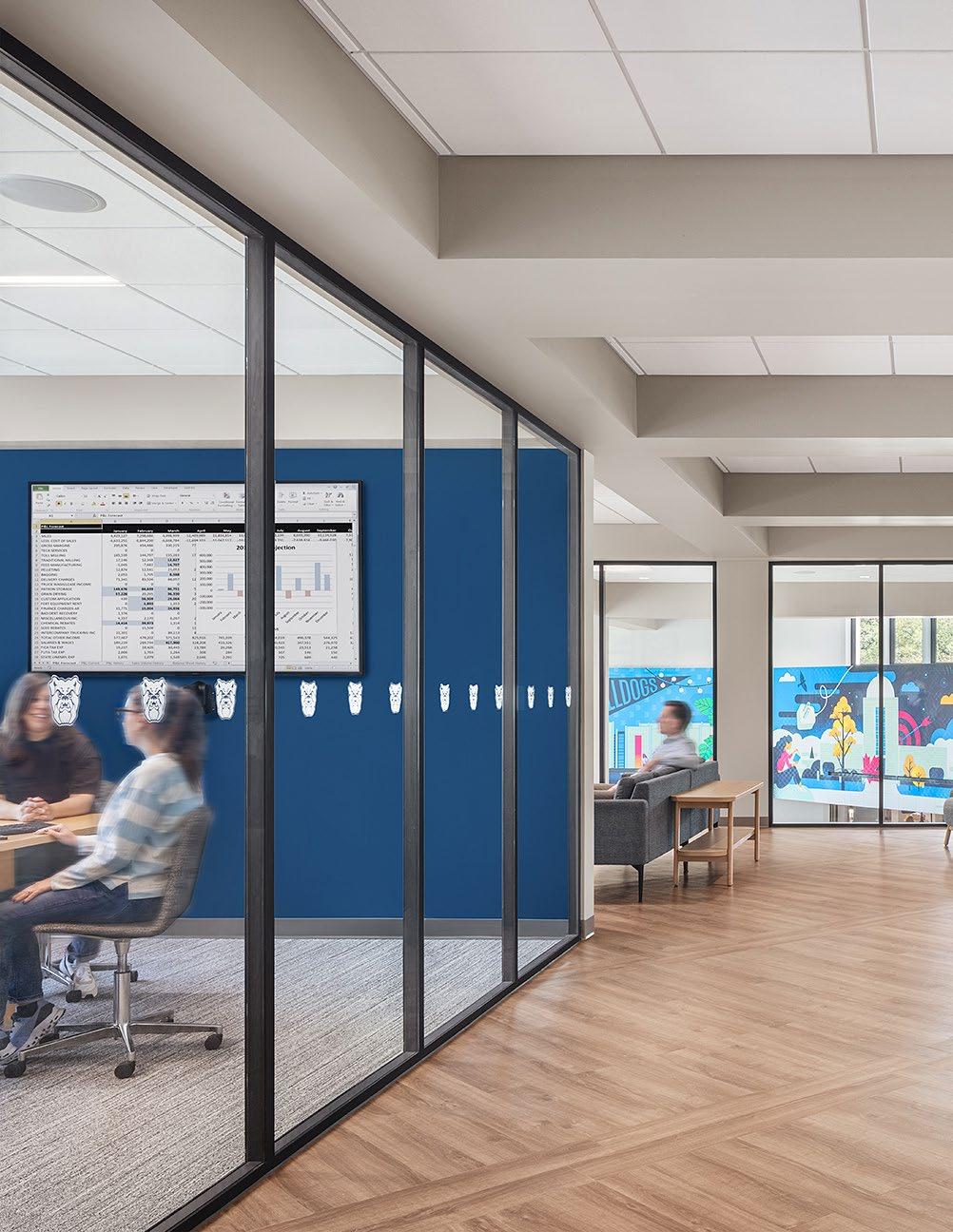
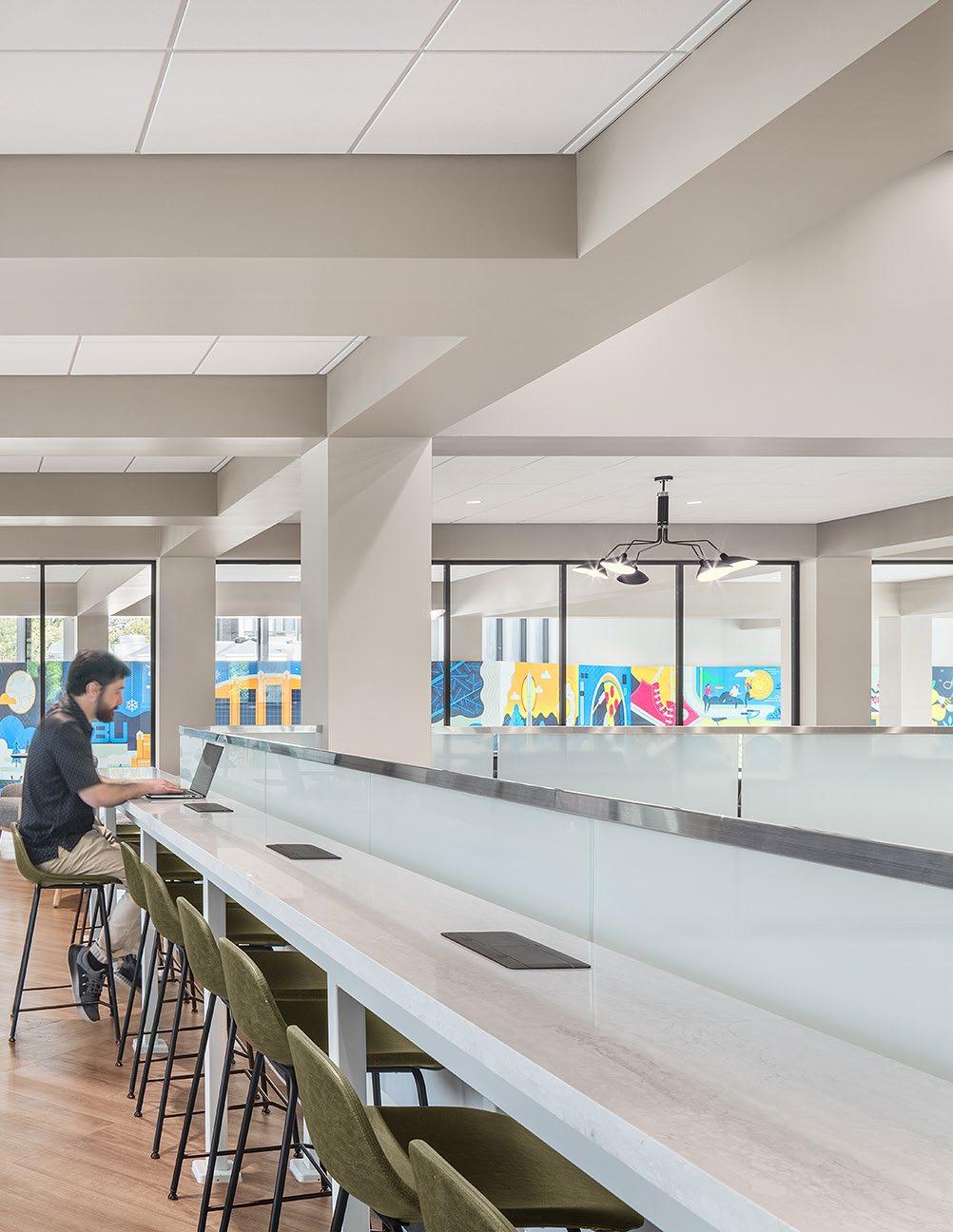
A
College (ResCo)
The dining hall was reimagined to serve the greater campus community. The 23,000-square-foot, 250-seat dining hall is open for lunch, dinner, and late-night service and offers a variety of fresh-made food options as well as an expanded grab-and-go. An expanded servery and double-height main seating area creates a bright and welcoming space.
By utilizing existing architecture and all furniture dining solutions, the space is flexible, allowing the university to close the servery and keep the seating area open as study space. A variety of seating types serve both diners and those studying.The design team was challenged to overcome the perception of the building’s exterior, which stands in contrast to the campus’ more collegiate gothic vocabulary, while integrating the residential and dining experience within the Butler tradition. Thus, the vision for the interior design leaned heavily towards creating hospitalityforward, classically collegiate spaces in line with Butler’s distinct campus context. A large mural in the dining hall captures wellknown places and cultural campus references.
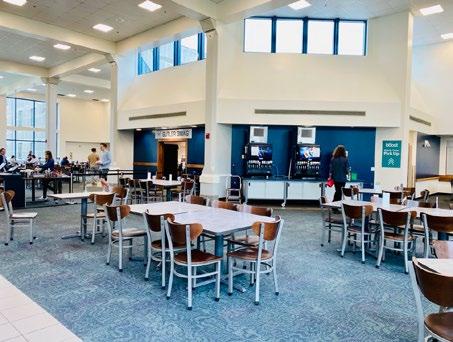
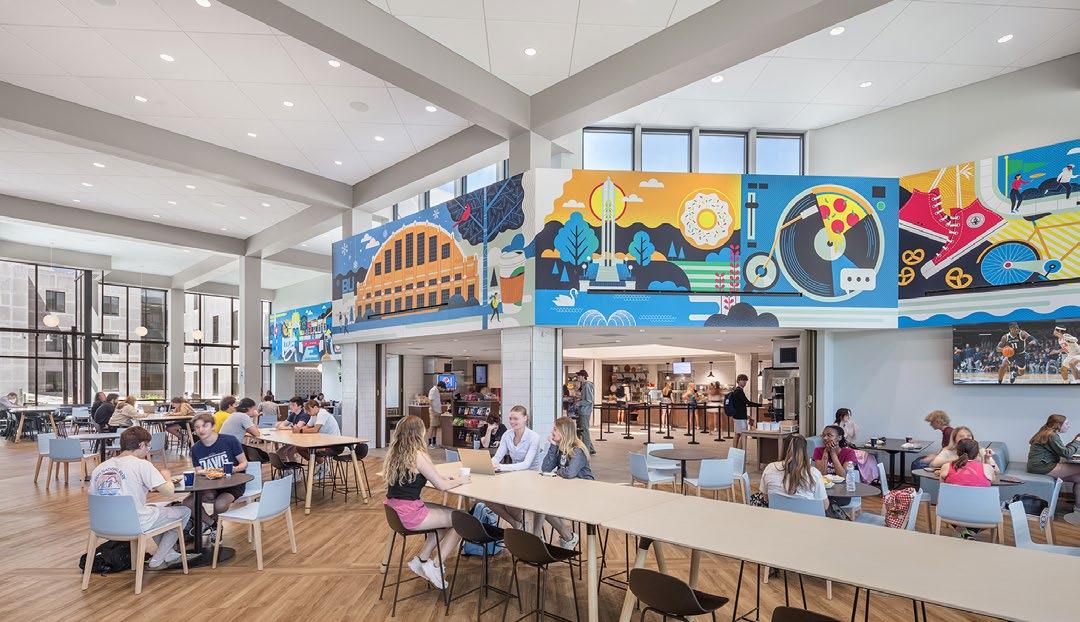

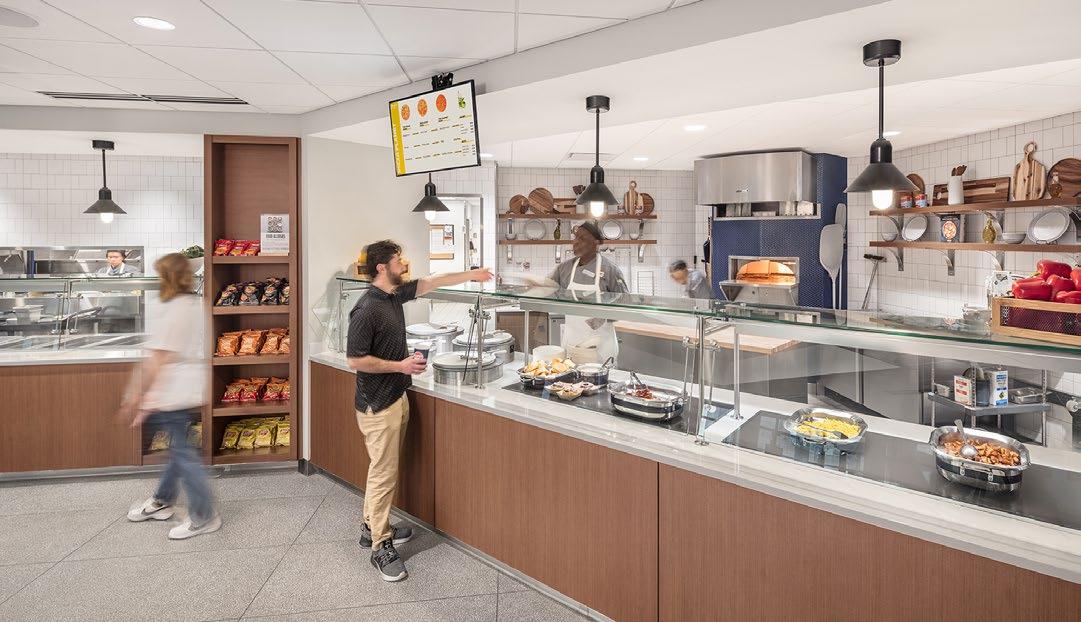
College (ResCo)
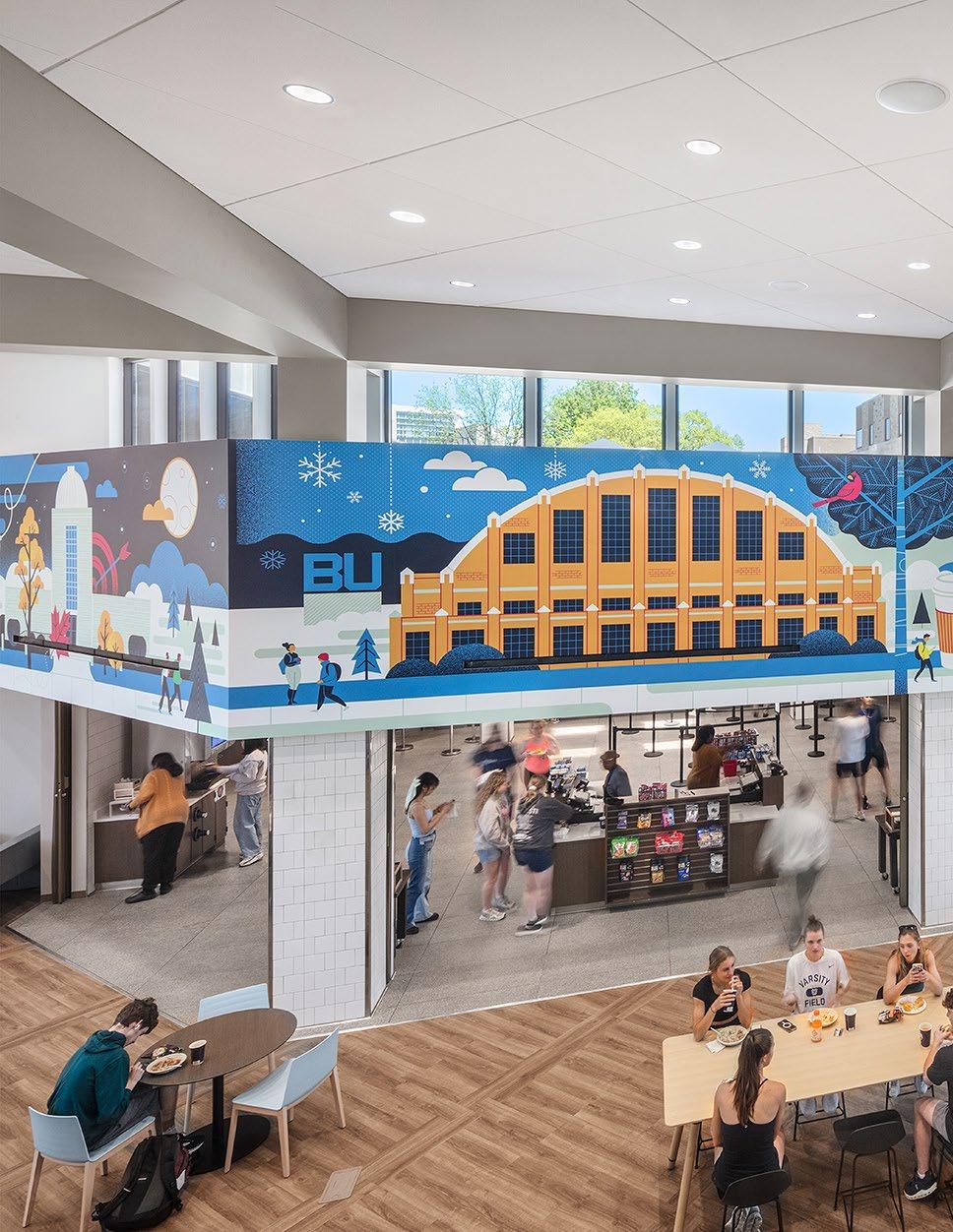
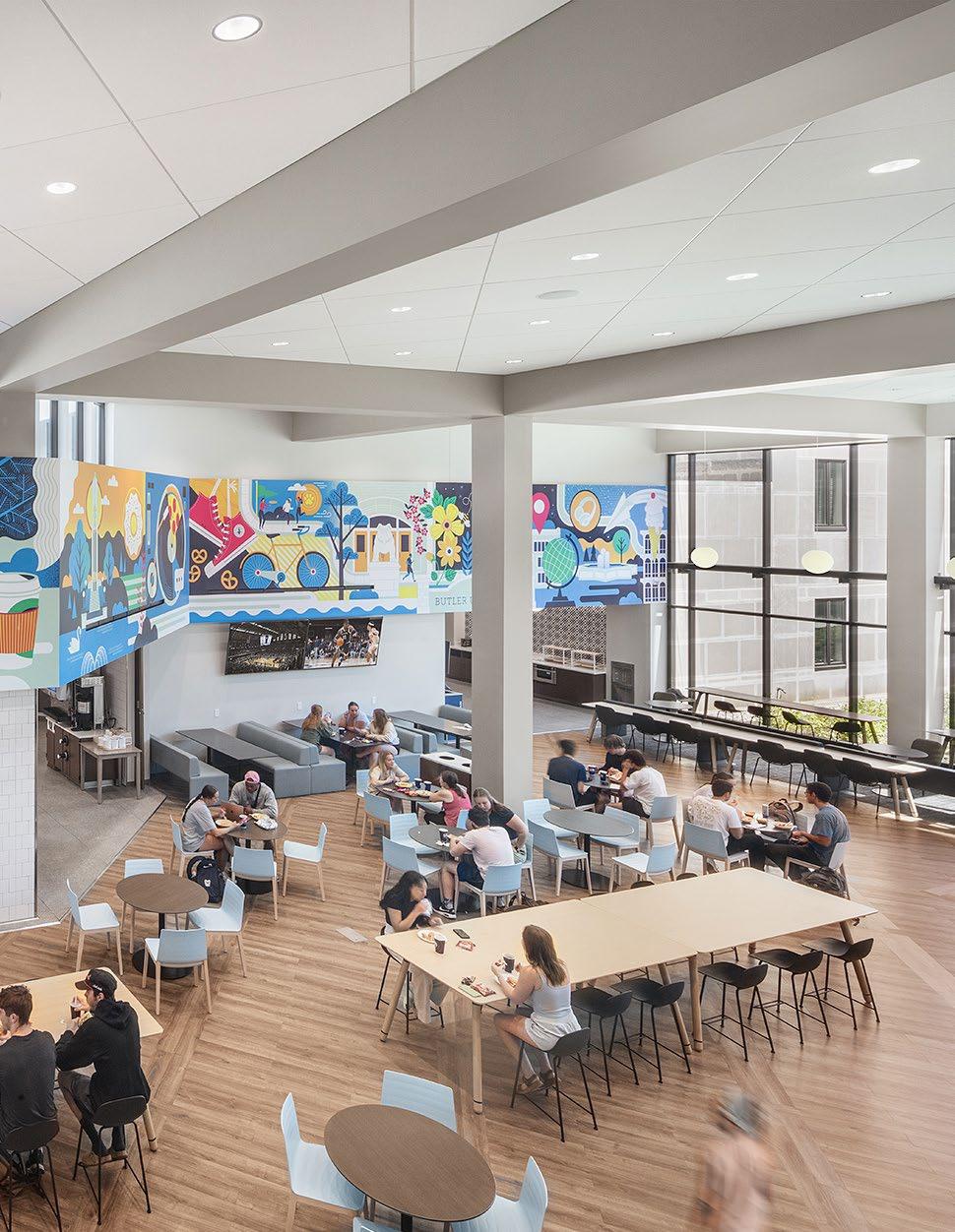
Criteria is scored on a scale of one to ten, with one representing poor and ten representing excellent.
NAME Orange Hall Conversion OUTCOME Conversion + Renovation
10.0
MASTER PLAN
Located at prominent campus intersection, adjacent to residence halls, student center, and academic core. Potential for replacement of existing parking garage with new addition.
7.0
STRUCTURE AND ENCLOSURE
Solid pre-cast and concrete structure. Well performing pre-cast façade, though aesthetically challenging. Window conditions adequate, but potential for future upgrades or replacement.
4.0 FLOOR PLANS
BUILDING SYSTEMS
Significant replacement and upgrades necessitated by change of use to residential and to meet University standards.
7.0
10.0
Hotel rooms are acceptable unit type for student housing. Potential to add amenity spaces at logical points within typical occupant floor plan.
COST AND VALUE
Cost of conversion significantly less than new construction and speed to occupancy much faster.

Client: Syracuse University
Location: Syracuse, NY
Size: 160,000 sf, 420 beds
Facing the need for additional on-campus housing, Syracuse University engaged SCB to conduct a feasibility study on converting the university-owned Sheraton Hotel and Conference Center. Following the study, SCB was commissioned to provide design services for the adaptive reuse of the hotel into an undergraduate residence and dining hall.
The primary goals of the project were to maximize bed count and introduce new community spaces with a minimal level of intervention to bring the residential program on-line as quickly as possible. The project was divided into two phases, with construction scheduled over two consecutive summers. Phase One, completed in August 2024, converted the majority of the existing 235 hotel rooms into double-occupancy units with private bathrooms, resulting in 421 student beds. On the first floor, a new entry lobby lounge was created with a secure point of access to the residential floors.
The former hotel restaurant was also repurposed in the first phase of the project. With six months until the start of the semester, the University challenged SCB to convert the space into a dining hall. The resulting 220-seat facility features a variety of self-serve food stations, serviced by a shared kitchen, along with a centralized beverage station. New finishes were selected to meet the aggressive schedule and University performance standards. White subway tiling and paint, along with new floors brighten the formerly dark and moody bar and grill.
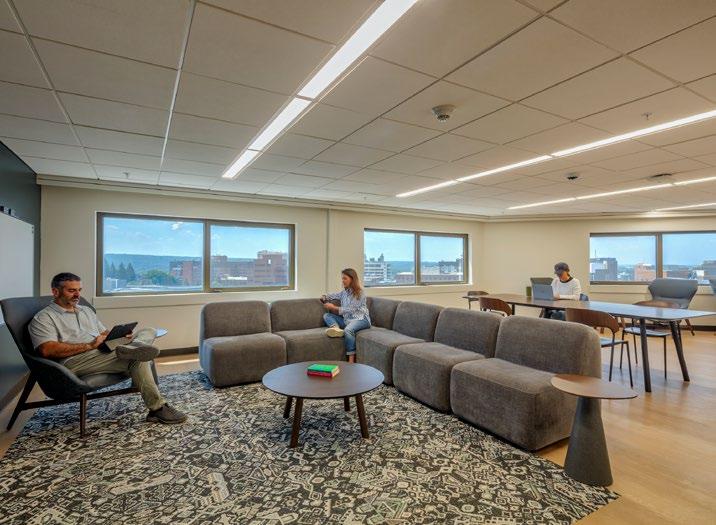
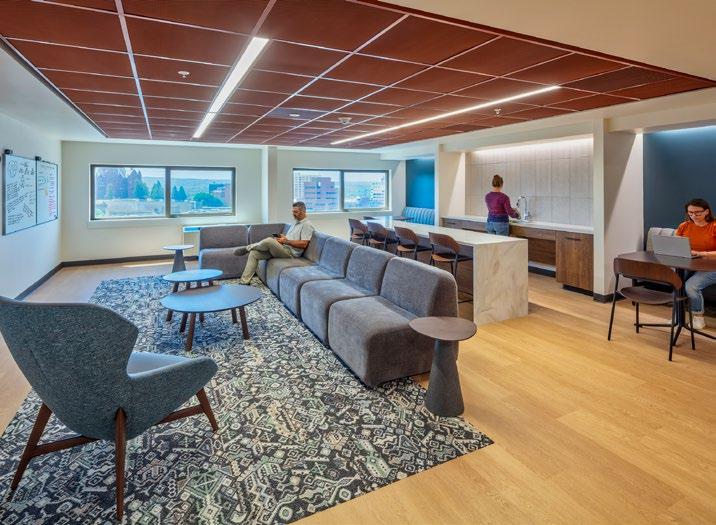


Orange Hall
Phase Two, completed in August 2025, introduced new social and academic amenities on each level. Former corner hotel suites now serve as dedicated study spaces. The building’s centrally located elevators open into new social lounges, which were created by converting two former guest rooms. Each lounge enjoys a view to the campus and was designed to evoke the comfort and character of a living room, inviting residents to come out from their rooms and connect. Warmtoned stone and wood, tactile upholstery, and patterned area rugs look and feel like home while meeting university standards for durability. Each lounge is equipped for both relaxation and collaboration, featuring a wall-mounted TV, whiteboards for ideation, and a modular sectional that can be reconfigured for group study or casual hangouts. A bar-height island with seating, a counter with sink, and two cozy banquette nooks further support gatherings. A ceiling of perforated rustcolored metal panels subtly references Syracuse’s school color, the namesake of building’s new identity as Orange Hall.
With schedule and budget top of mind for this fast-tracked project, the design team prioritized maximizing efficiencies and retaining elements of the original hotel, where possible. Existing windows, unit entries, and ceilings were preserved, along with much of the original wall layout. Finishes including flooring, furniture, door hardware, lighting, and corridor ceilings, were replaced or upgraded. In addition, many of the building systems received significant updates: new IT infrastructure was installed throughout, PTAC units in the now residential rooms were replaced, and electrical and plumbing improvements were made where needed.
Levels 4-8
SCB is an architecture, planning, interior and urban design firm. Founded in Chicago in 1931, SCB provides design services from four locations across the US.
SCB is at the forefront of dense urban living, innovative workplaces, inspiring learning environments, resilient infrastructure, and vibrant communities. Through the collective impact of nearly a century of work, the firm has made an indelible mark on the contemporary landscape.
SCB has designed over 38,000 beds of on-campus student housing. Our portfolio reflects the variety and uniqueness of the institutions we serve and addresses a broad range of needs and building types. From freshman and graduate residences, high-rise and low-rise campus scales, urban and suburban contexts, new facilities and renovated vintage structures - our work offers creative solutions that are tailored to each campus.
